
 Aktif Konular
Aktif Konular  Üye Listesi
Üye Listesi  Takvim
Takvim  Arama
Arama  |
 Aktif Konular Aktif Konular  Üye Listesi Üye Listesi  Takvim Takvim  Arama Arama |
| |
| Tayyareler | |
| |
  |
| << Önceki Sayfa 4 Sonraki >> |
| Yazar | Mesaj |
|
Nick_Karatzides
Üye 

Kayıt Tarihi: 06/06/2009 Aktif Durum: Aktif Değil Gönderilenler: 250 |
  Gönderim Zamanı: 10/08/2014 Saat 23:11 Gönderim Zamanı: 10/08/2014 Saat 23:11 |
|
Each complete kit contains the basic frame sections, the elevator & rudder fins, the landing gear wheels, the 7-cylinders radial engine, the upper rotor transmission & gearbox, the rotor heads & rotor blades, the two cylindrical 25 litres fuel tanks (V21 kit only), the cockpit compartment with front & side instrument panel, the control stick with thrust & collective levers & the rudder pedals, both crew seat frames (2nd seat for V21 kit only), a couple of cowling & opened for maintenance hatches and plenty of additional minor details such as supporting rods, control bars, knuckle joints, pulleys, hinges, D-rings etc, etc, etc. Some cable wires & rigging will be later added manually. As said before, any extra diorama accessories visible on some pictures (eg. engine's stand, fuel drums, fire extinguisher, jerrycans, wheel chokes, wooden ladder etc) are not included into kit but is possible to get 3D printed and be purchased separately.
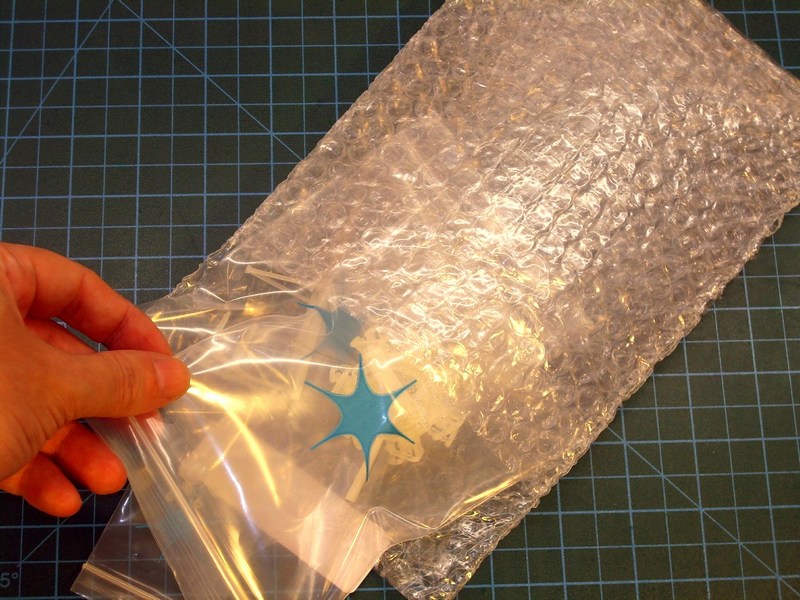
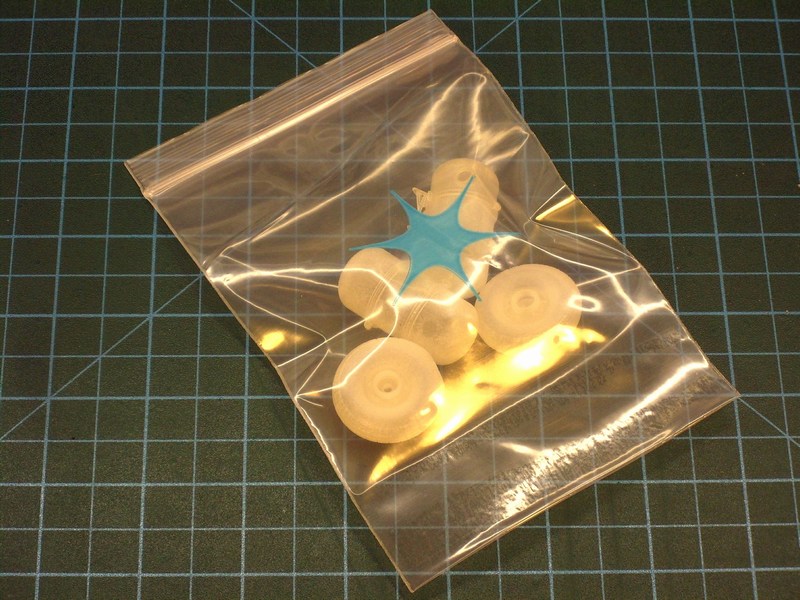
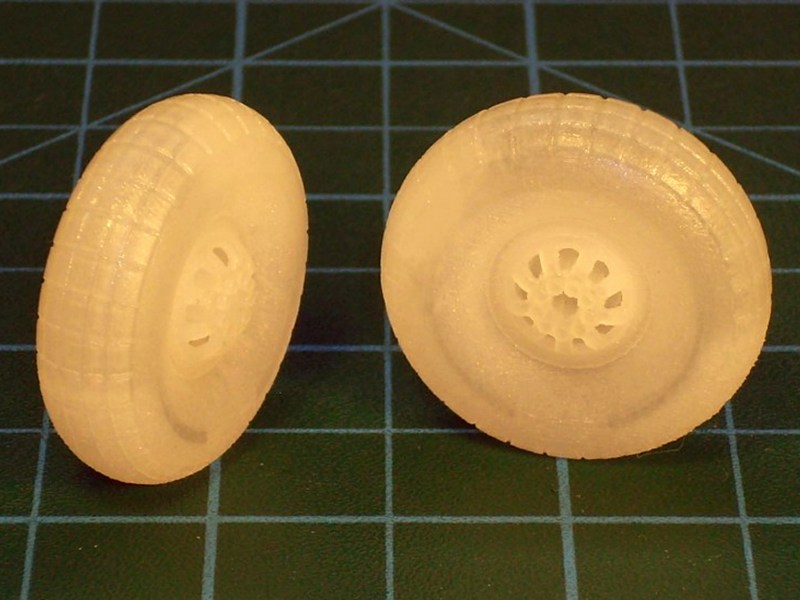
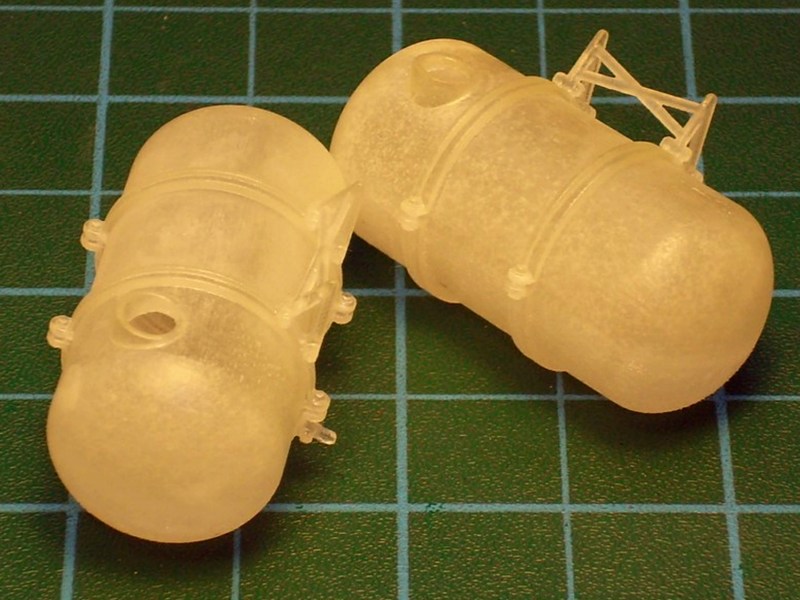
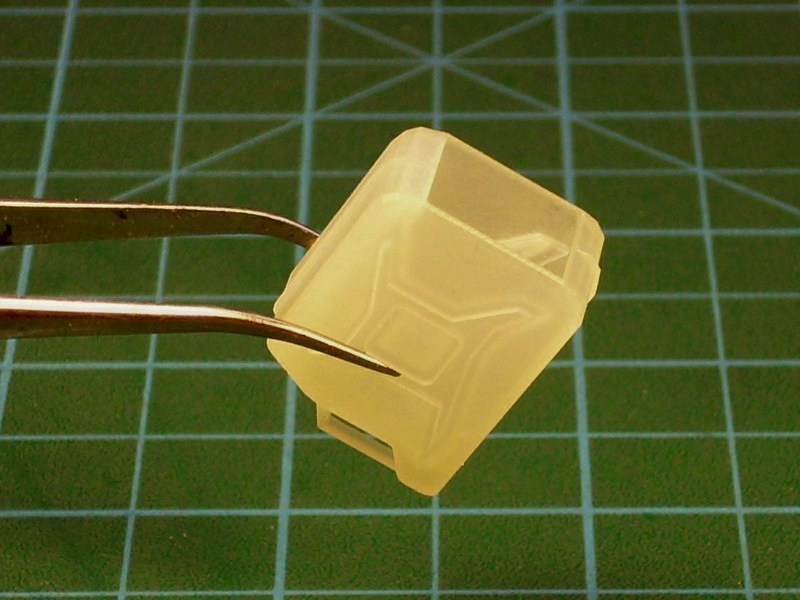
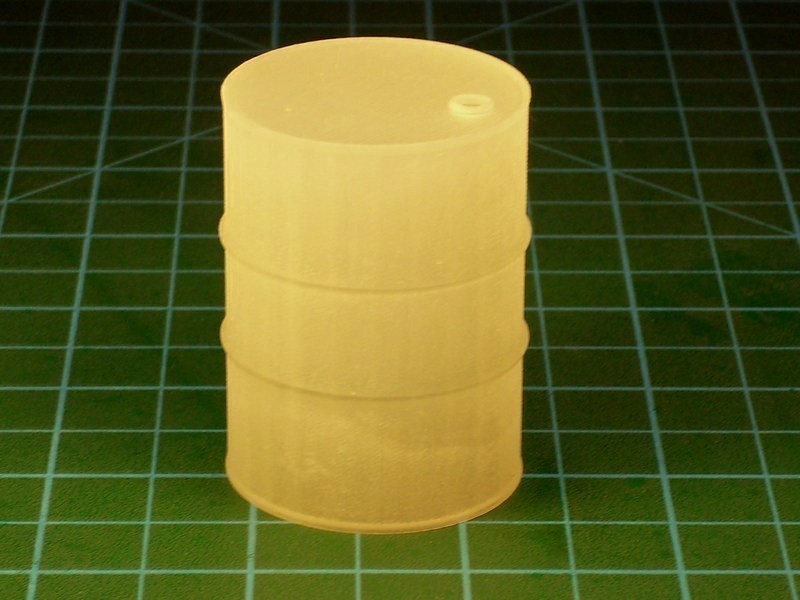
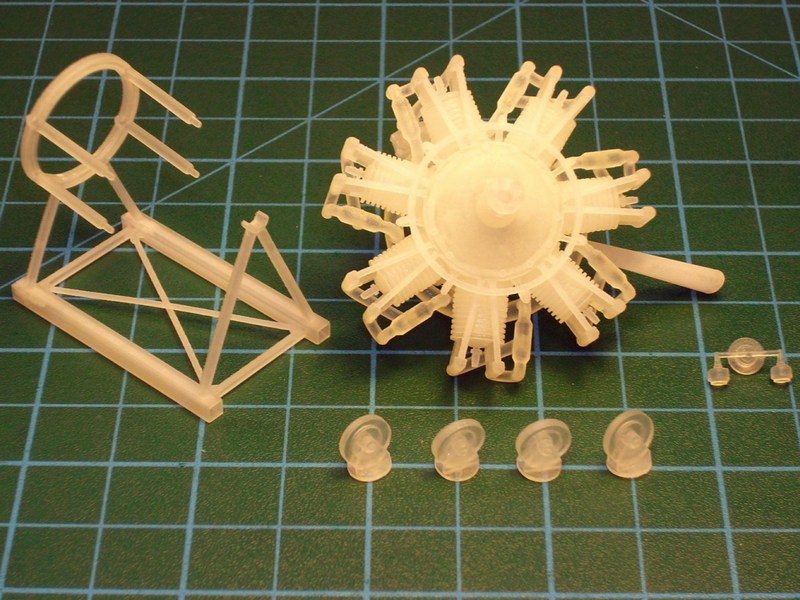 Düzenleyen Nick_Karatzides - 27/07/2018 Saat 12:13 |
|
 |
|
|
levburkara
Üye 
Kayıt Tarihi: 11/12/2009 Konum: United States Aktif Durum: Aktif Değil Gönderilenler: 579 |
  Gönderim Zamanı: 12/08/2014 Saat 04:45 Gönderim Zamanı: 12/08/2014 Saat 04:45 |
|
I look forward to the next steps. I first came across zenithal lighting while admiring the works of Diego Quijano:
The F-104 article (though by Ricardo Rodriguez, not by Diego) was very informative: http://dqscaleworks.blogspot.com/p/articles.html There is a long discussion of how to best simulate zenithal lighting with colors and shades. I am sure there are tons of other articles elsewhere. In general, Diego's site is full of very attractive models and articles: http://dqscaleworks.blogspot.com I am drawn to all the airplane works, but others categories are also mind blowing. You're probably already familiar with these, but wanted to share these as others may also find them useful. I am not sure what I think about that zenithal method though. Like many other things, subtlety is key and I can see why going overboard with that can quickly diminish the attraction. So the Spanish way seems to exaggerate things a little too much for my taste (see the Mig-21 there), and some of these lighting tricks get too pronounced. However, my view is just a matter of taste and opinion and I greatly appreciate the techniques. Will be interesting to see your results. |
|
 |
|
|
Nick_Karatzides
Üye 

Kayıt Tarihi: 06/06/2009 Aktif Durum: Aktif Değil Gönderilenler: 250 |
  Gönderim Zamanı: 18/08/2014 Saat 15:00 Gönderim Zamanı: 18/08/2014 Saat 15:00 |
|
Orjinalini yazan: levburkara Well, I agree that the "Spanish way" seems to exaggerate things and sometimes looks a little too much. But, since we are talking about an artistic approach, I think, that these small artistic excesses emphasize a whole style in our hobby. As final, it may not be 100% accurate to reality, but somehow it looks nice & acceptable by our own eyes - and that is what really matters.
I am not sure what I think about that zenithal method though. Like many other things, subtlety is key and I can see why going overboard with that can quickly diminish the attraction. So the Spanish way seems to exaggerate things a little too much for my taste (see the Mig-21 there), and some of these lighting tricks get too pronounced. Orjinalini yazan: levburkara This Flettner Fl-282 V21 Kolibri helicopter (available in "cutaway" version too) and a Bleriot XI-2 1912 era monoplane model as used by Turkish / Ottoman Army during Balcan Wars period), both designed & produced in huge 1/18 scale, are available for sale as full 3D printed kits, produced on high-precision 3D printers by using best available polymer plastic material to ensure the best printing results & highest possible quality on kit parts. Interested collectors, scale modelers & hobbyists could follow the building process and have a look on Work-In-Progress detailed pictures.
Will be interesting to see your results. Click on Anyuta 3D printed scale models online catalog to have a look. 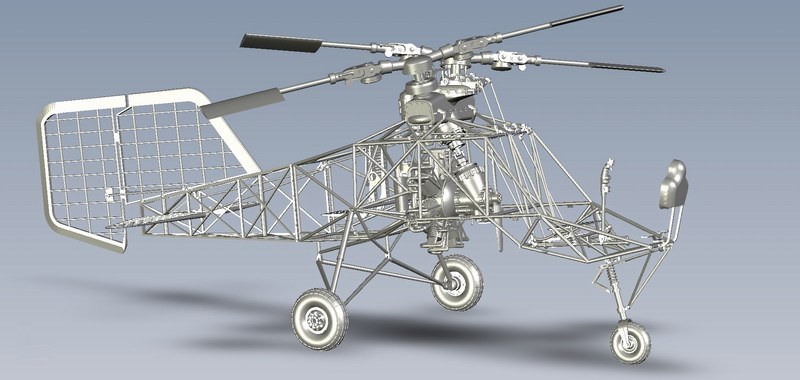
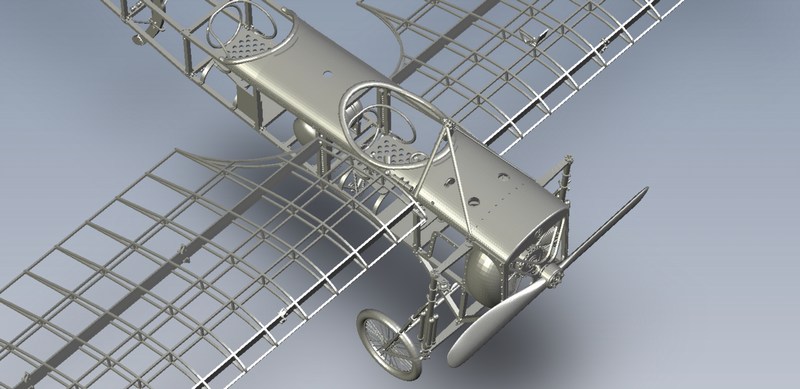
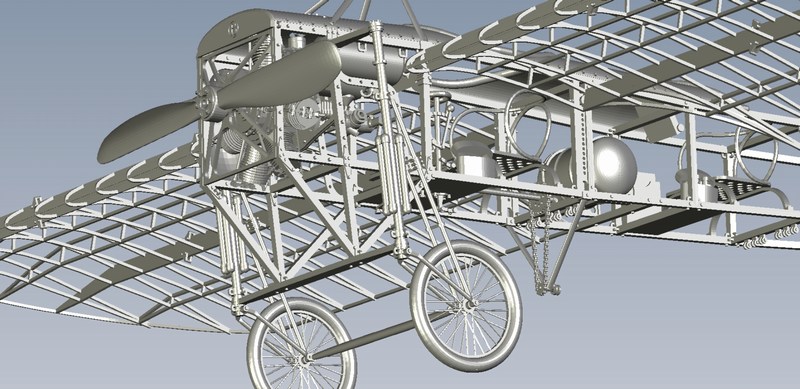
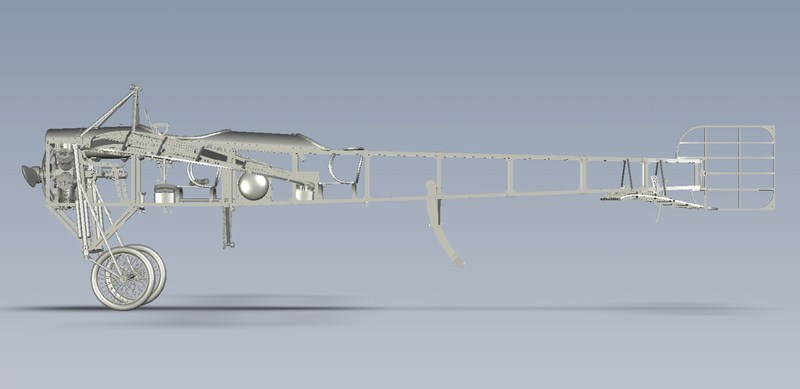 Düzenleyen Nick_Karatzides - 27/07/2018 Saat 12:15 |
|
 |
|
|
Nick_Karatzides
Üye 

Kayıt Tarihi: 06/06/2009 Aktif Durum: Aktif Değil Gönderilenler: 250 |
  Gönderim Zamanı: 01/02/2016 Saat 03:05 Gönderim Zamanı: 01/02/2016 Saat 03:05 |
|
Its been a long time, more than one year as far as I can remember, since my last update into this forum - not unreasonably as youll find out by reading the following lines. You see, 2015 almost as a whole year, was for me and my family - or at least what is left of it - a very bad year. Life is full of surprises and reminds us daily that we are only human beings, absolutely vulnerable to almost anything. Life prooves by most cruel way that we can become nothing more than dust and faded memories, at any moment, in just a blink of an eye. The following text and attached photos are about two years old and were supposed to be published on scale model related forums & magazines in late 2014 or early 2015. Unfortunately, we may make our plans but God has the last word and decided to take my angel for a while until well meet again on the other side. I'm not worried - I know she is patiently waiting for me to join her some day and I pray for this day to come soon.
Although the above lines are not directly related to a hobby forum, sharing my thoughts with fellow scale modelers, relieves pain and makes grief a little softer. However, I would greatly appreciate if public comments & responses will be exclusively focused on scale modeling matters. 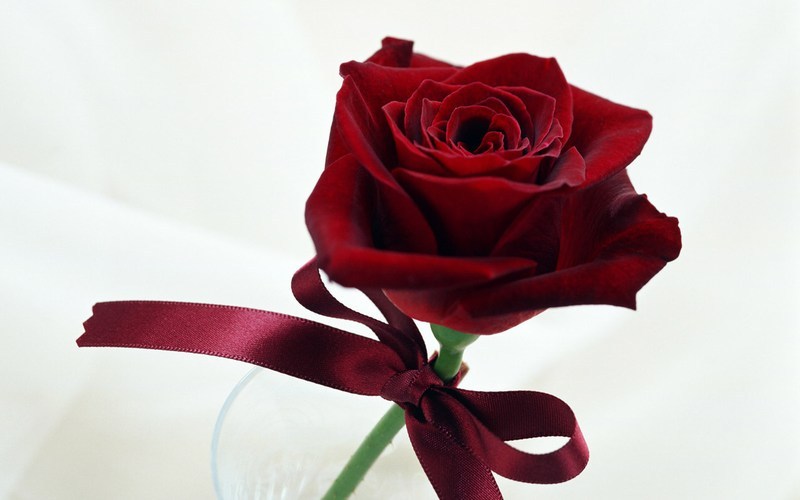 Düzenleyen Nick_Karatzides - 27/07/2018 Saat 12:15 |
|
 |
|
|
Nick_Karatzides
Üye 

Kayıt Tarihi: 06/06/2009 Aktif Durum: Aktif Değil Gönderilenler: 250 |
  Gönderim Zamanı: 01/02/2016 Saat 03:47 Gönderim Zamanı: 01/02/2016 Saat 03:47 |
|
When I first got this 3D printed kit in my hands, I noticed that most of the kit parts had slight traces of oil on their surface, so each time I touched the parts, my fingertips become oily. What really happened? Obviously, after the 3D printing process was finished and the kit parts been removed from the printer tray to be washed into an ultrasonic oil bath and later an ultrasonic water bath, some oil traces escaped the clean inspection and dry by hand procedure. When I later examined all parts by touching one by one with bare hands, I accidentally transferred the oil traces to every single part. When I realized it, it was already late. Well, it was not exactly a doomsday, but the kit parts should be cleaned thoroughly, because even the slightest trace of oil on the surface of model, could potentially be a problem in the painting process. Simplicity makes things flow without effort and oil traces could easily be completely removed by sinking everything into a 2 litres plastic bowl filled with White Spirit and leave it there for few minutes to wash oil traces. Shortly after all kit parts enjoyed their bath into a White Spirit filled bowl, they were washed with liquid soap and warm water and placed on soft paper towels and allowed to dry.
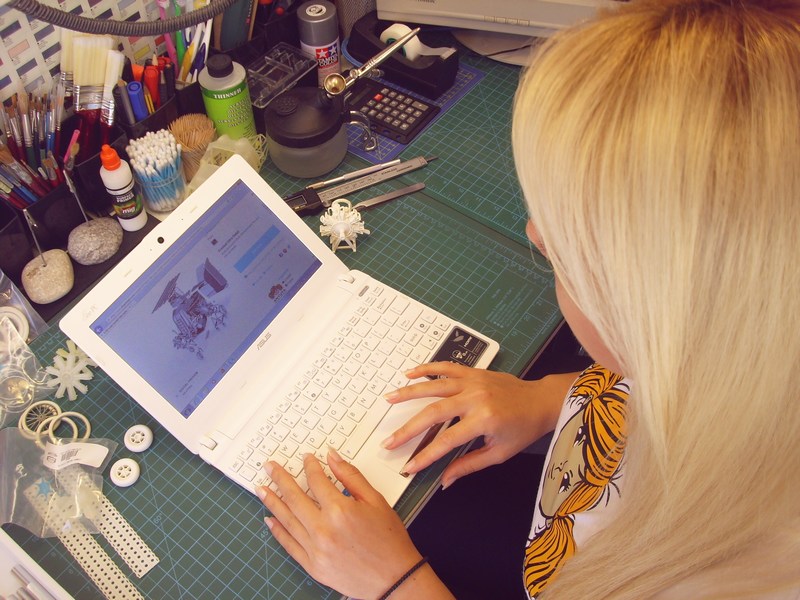
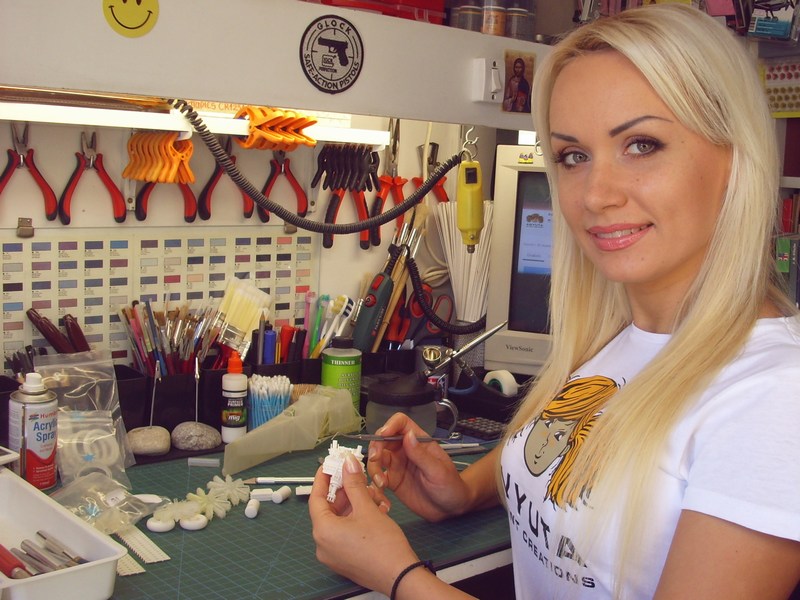
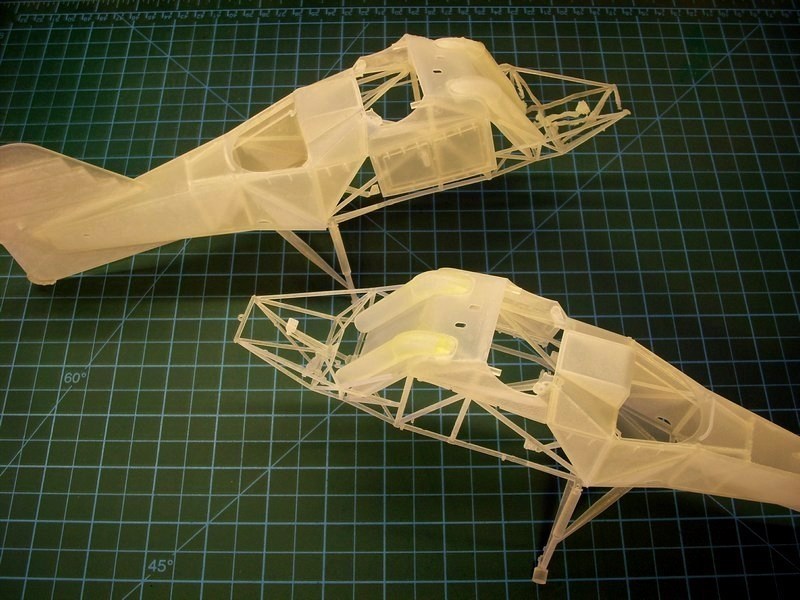
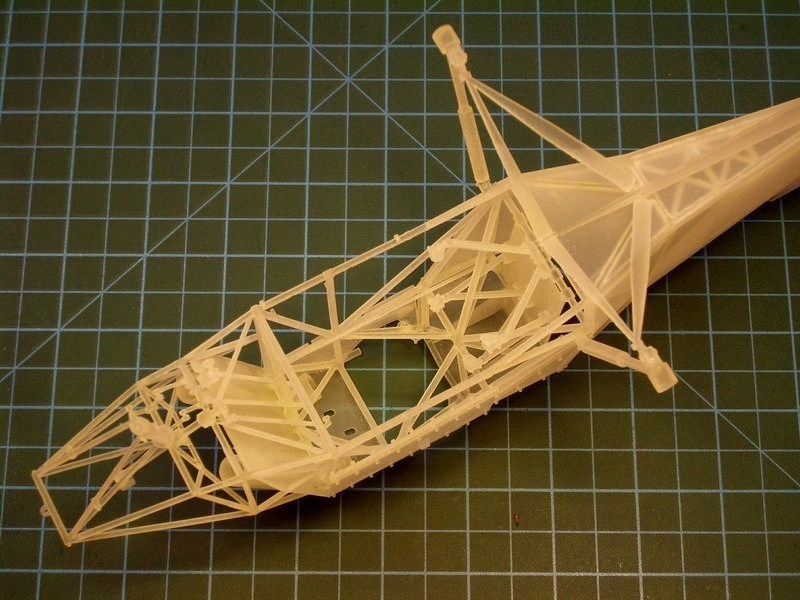 After all kit parts washed in White Spirit & water to clean the oil traces, every section of the model has been repeatedly dry fit tested to ensure that all individual parts could be later combined together as an overall built model. When looked OK to me, each part sprayed over with Ammo Mig Jimenez AMIG2004 White waterborne polymer primer to spot mistakes and prepare for paintjob. The next day, I did a visual inspection and shot some pictures. It looks that overall white primer, really helped to visually pop-up the printed detail and proved that use of best available 3D printing material resulted smooth and glossy surfaces on kit parts. As always, the final check held by my sweetheart wife who conducted a strict quality control and 3D printing result evaluation. With persistence on detail, she examined each one of the kit parts and compared them with the CAD design on computer screen. In fact, she spotted an almost undetectable tiny crack on a frame rib inside the helicopter fuselage, which had escaped my visual inspection earlier. Once the process complete, she smiled & proudly signaled green light for further building. 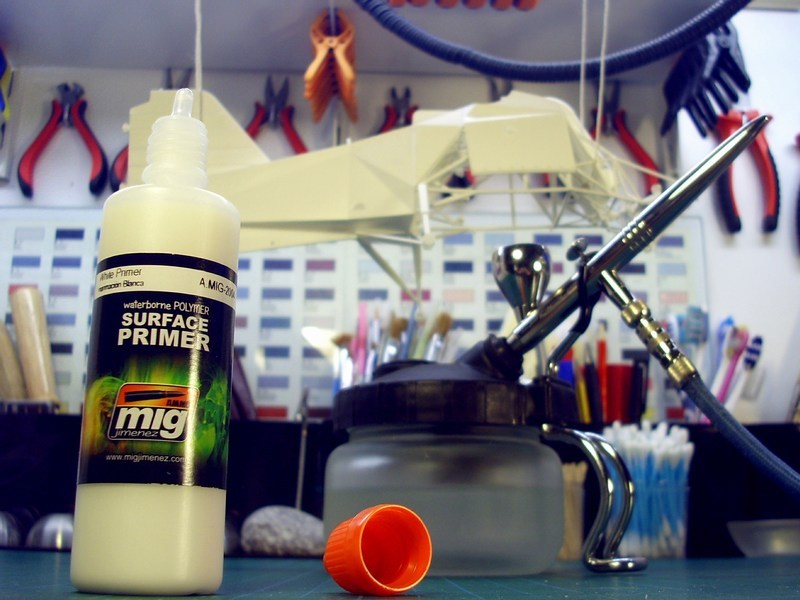
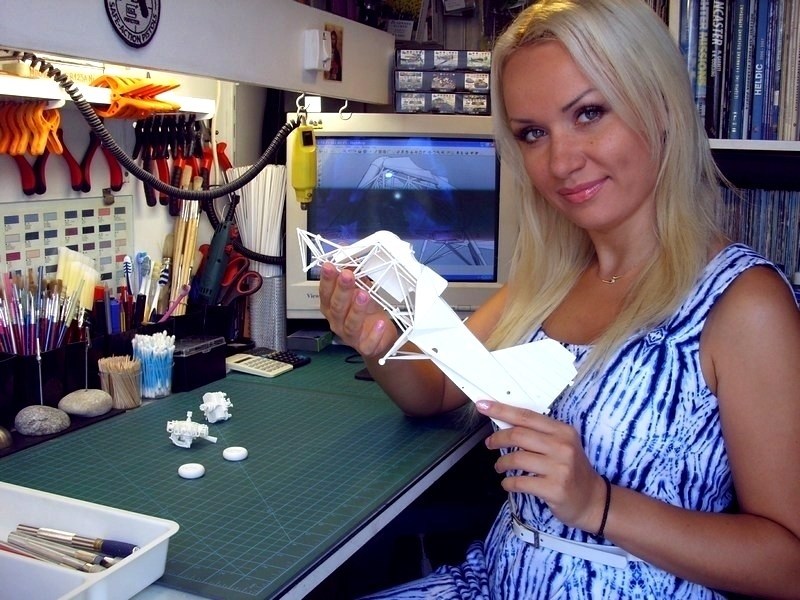 Düzenleyen Nick_Karatzides - 27/07/2018 Saat 12:16 |
|
 |
|
|
Nick_Karatzides
Üye 

Kayıt Tarihi: 06/06/2009 Aktif Durum: Aktif Değil Gönderilenler: 250 |
  Gönderim Zamanı: 01/02/2016 Saat 03:55 Gönderim Zamanı: 01/02/2016 Saat 03:55 |
|
As soon as the parts were already cleaned & dry fit tested, it was about time to start assembling everything as one model. I usually follow two simple rules while attempting to assemble kit parts and later paint a model: - Paint the individual parts first and assemble the scale model later or - Assemble all individual parts first and paint the overall built model later. First option seems as more appropriate - it would surely make my life easier to paint individual parts first and assemble all together later. As already wrote into previous paragraphs, the model was 3D designed in such a way so as to avoid creating gaps between the parts to be later assembled. Notice that, no filler putty used and no sanding done throughout the whole process! Most of the kit parts, such as the tail rudder & horizontal stabilizer fins, the pilots & observers seats, the main & nose landing gear wheels, the cylindrical fuel tanks, the upper gearbox and of course the rotor blades will separately paint, weathered and later be attached on models overall structure using CA superglue, which does bonds in only few seconds, reaches extremely strength at room temperature and it is suitable for materials such as wood, rubber, plastic, metal, ceramics, leather, marble, polyethylene, polypropylene, teflon etc. On the other hand, there were few tiny parts such as some hinges & D-rings on main fuselage and gearbox complex that had to be assembled before painting process start. Düzenleyen Nick_Karatzides - 27/07/2018 Saat 12:17 |
|
 |
|
|
Nick_Karatzides
Üye 

Kayıt Tarihi: 06/06/2009 Aktif Durum: Aktif Değil Gönderilenler: 250 |
  Gönderim Zamanı: 01/02/2016 Saat 04:16 Gönderim Zamanı: 01/02/2016 Saat 04:16 |
|
Before dealing with this project, I had the (false) impression that Kolibri helicopters were all same - at least identical. After all, only 24 were produced. Once again I was wrong. Study & research on available printed material, 3view diagrams, photographs and videos actually reveals that there were plenty of differences between them - obvious differences or just small details identified after careful observation. In some cases, the exact same helicopter (for example the V12 with registration CJ-SF) was appeared once to be painted with Kriegsmarines medium grey camo (click HERE) and later with Luftwaffes dark green colours (click HERE) or even once having the flat plexiglass panels around the cockpit installed and latter simply missing them. On the other hand, the two-seater Fl-282 V21 helicopter registered as CI-TU, maybe the most famous of the Kolibris, was quite unique. In following picture, dressed up with Luftwaffes TransportStaffel TS40 colours, as appeared at Ainring AB at Mühldorf, Bavaria, in its operational role as artillery spotter, back in 1944 to 1945 days. 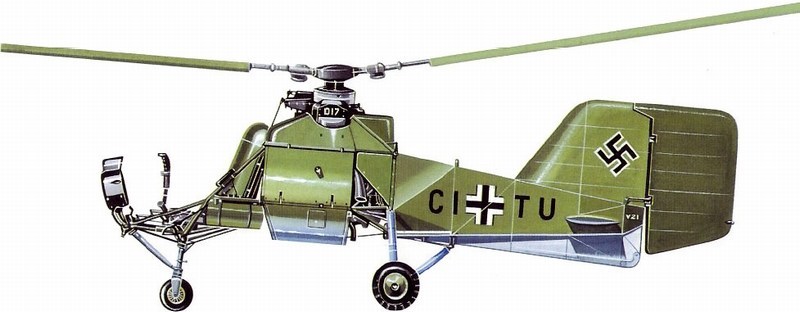 Düzenleyen Nick_Karatzides - 27/07/2018 Saat 12:17 |
|
 |
|
|
Nick_Karatzides
Üye 

Kayıt Tarihi: 06/06/2009 Aktif Durum: Aktif Değil Gönderilenler: 250 |
  Gönderim Zamanı: 01/02/2016 Saat 04:48 Gönderim Zamanı: 01/02/2016 Saat 04:48 |
|
To recreate the Fl-282s Luftwaffe camo paint, I did use the Life Colors Gerrman WWII Luftwaffe set #1 6-pack set, of 22 ml bottles.
- Life Color UA501 RLM 70 Schwarzgrün / Black Grey acrylic paint, - Life Color UA502 RLM 71 Dunkelgrün / Dark Green acrylic paint, - Life Color UA503 RLM 65 Hellblau / Light Blue acrylic paint, - Life Color UA504 RLM 02 Grau / Grey acrylic paint, - Life Color UA505 RLM 79 Sandgelb II / Sand Gold II acrylic paint and - Life Color UA506 RLM 80 Olivgrün / Olive Green acrylic paint. 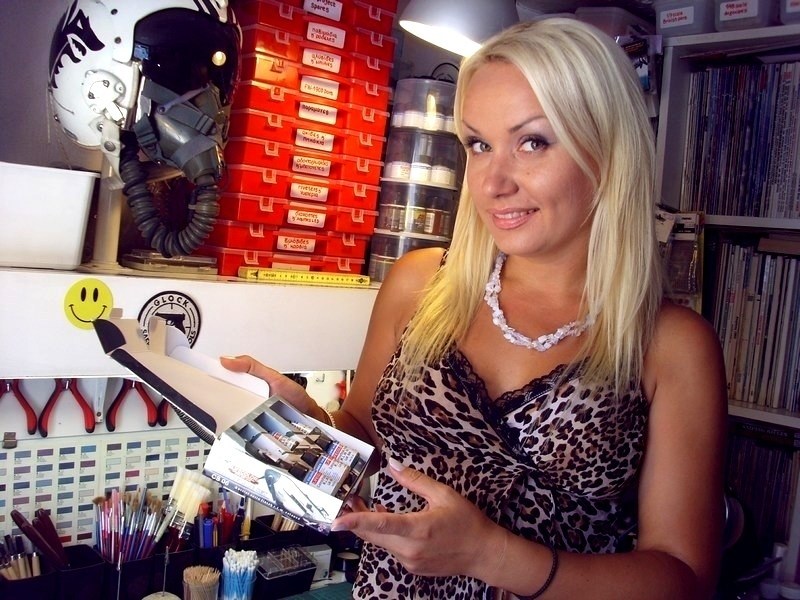
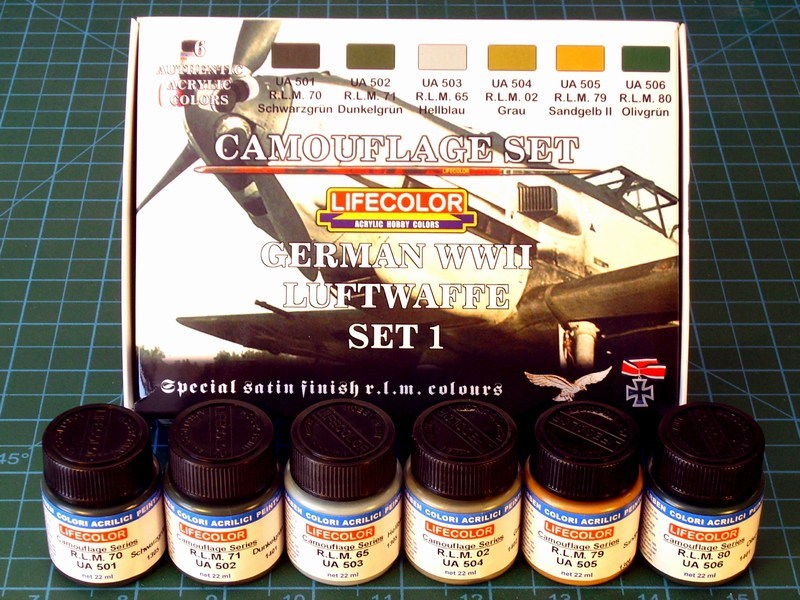 To be more specific, the basic colours applied on model according WWII Luftwaffe ReichsLuftfahrtMinisterium designations are the RLM 71 Dunkelgrün FS 34079 & RLM 65 Hellblau FS 26329 paints. 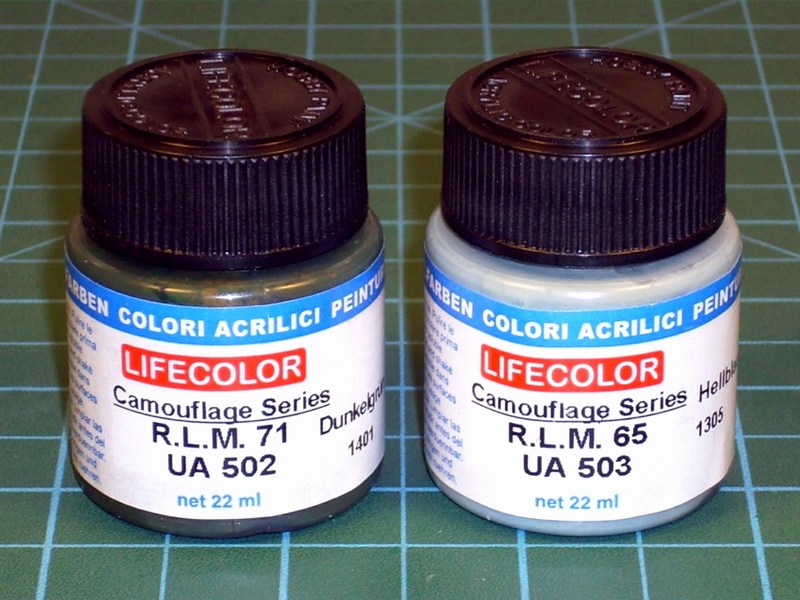 Düzenleyen Nick_Karatzides - 27/07/2018 Saat 12:18 |
|
 |
|
|
Nick_Karatzides
Üye 

Kayıt Tarihi: 06/06/2009 Aktif Durum: Aktif Değil Gönderilenler: 250 |
  Gönderim Zamanı: 01/02/2016 Saat 13:08 Gönderim Zamanı: 01/02/2016 Saat 13:08 |
|
Pre-shading by airbrushing dark coloured lines on model before the basic paint is a method followed by many modelers the last few years. To be honest, I never liked it, never really understood the reason to do something like that and yes, I admit that I never had some decent results whenever I tried it. IMHO adding pre-shading lines before painting is a time wasting & useless procedure with no artistic results on model. After all, whats the reason to try this, if (one way or another) additional paint layers will be applied on model later, to enlight or darken the basic paint? Anyway, I mostly prefer to:
- Directly apply the basic paint (without pre-shading and other time wasting nonsense) and later add some colour shades by enlightening or darkening on specific areas or - Follow the Francois Verlindens old-fashioned way by airbrushing a very dark colour (usually some black & dark brown mixture) all around the model until fully cover it and later gradually light-up the models surfaces by repeatedly applying very thin layers of basic paint. The abovementioned Francois Verlindens way possibly practiced by other painters & hobbyists decades before, was first introduced as a painting technique for scale modelling by Francois Verlinden, more than 25 years before. Back in the late 1980ies days, when the internet was not known yet and modelers only available reference was the (usually expensive) books from local hobby shop, a Belgian artist named Francois Verlinden managed to create 3D-alike light effects on flat surfaces. He did that by repeatedly airbrushing very thin layers of basic paint on a black (or dark brown) undercoat and then gradually lighten the dark surfaces to replicate the way that sunlight hits on large objects. Since then, some new painting tricks appeared and many modelers improved some older (and forgotten) techniques and re-introduced them as their own new inventions. During the last few years, the Francois Verlindens old-fashioned way was re-introduced and become popular around the scale modelling community (especially among armour painters), by its new name: Modulation! IMHO this modulation fashion looks nice on models but the results are not so strictly realistic comparing to the real world objects. As scale modelers, we always have to balance between realism factor and artistic expression. Yes, I admit that modulation effect does not accurately replicate the reality, but it looks so artistically attractive and becomes easily accepted by our visual subconscious. 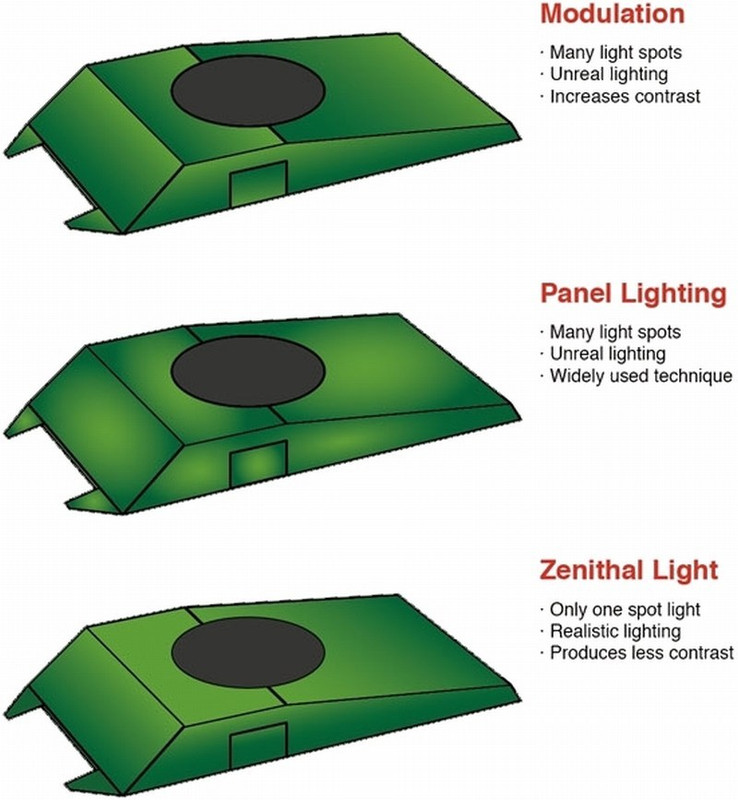
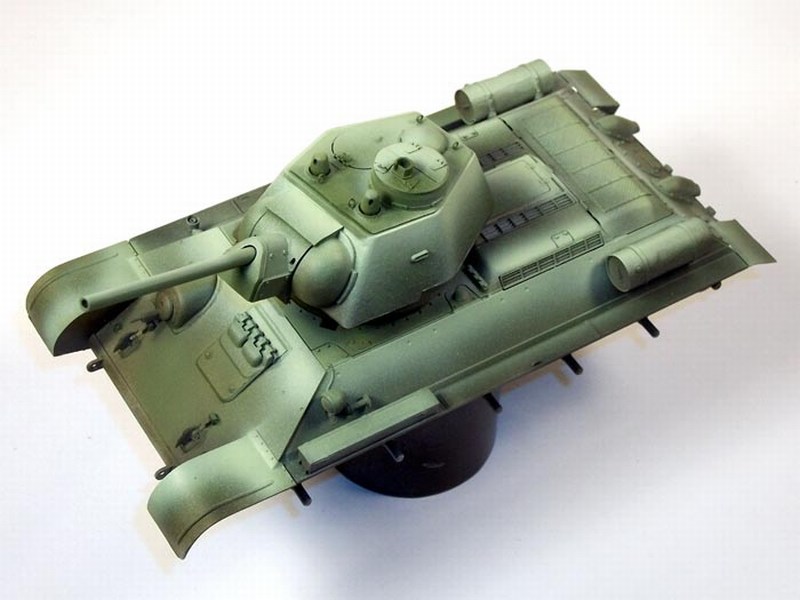 Process started, by airbrushing an overall undercoat mixture of 80% Life Color LC02 Matt Black and 20% Life Color LC37 Matt Burnt Umber acrylic, to prepare the flat surfaces for the basic paint which about to follow. Asking a blonde to paint it black could be confusing for a moment and result some priceless answers. 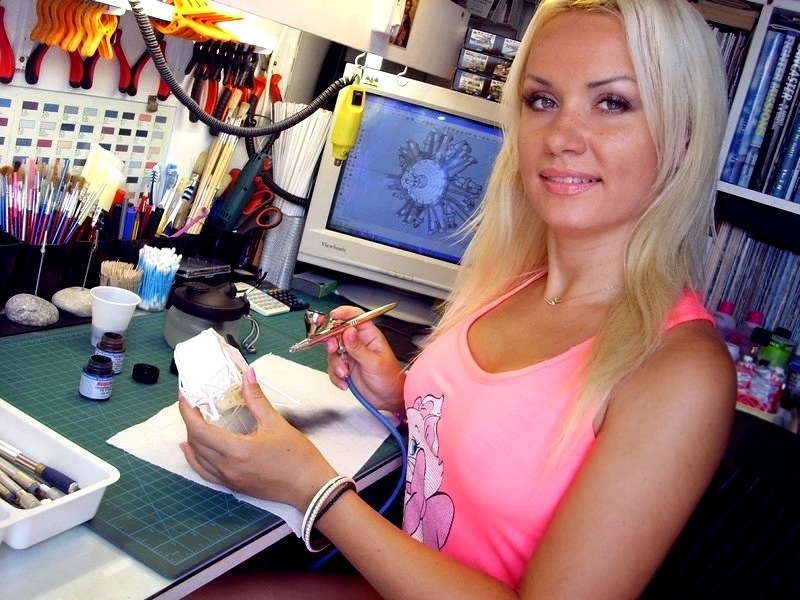
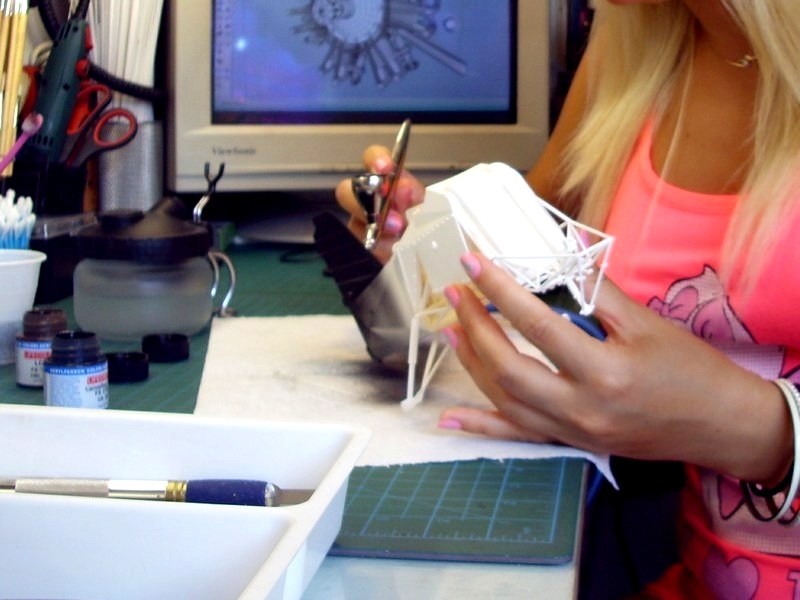
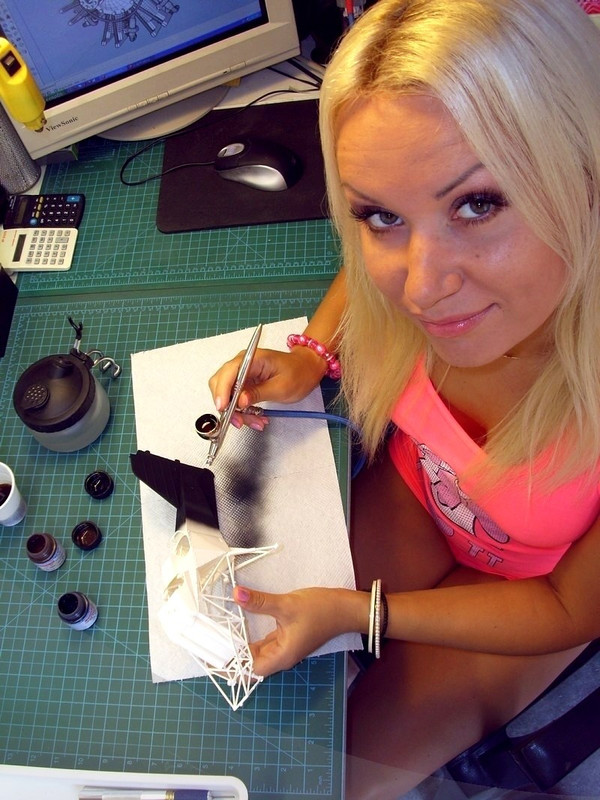
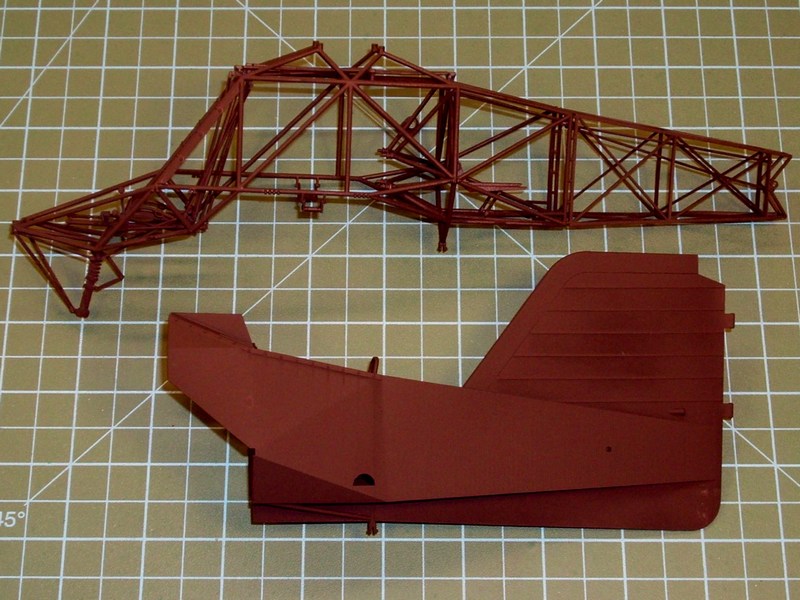
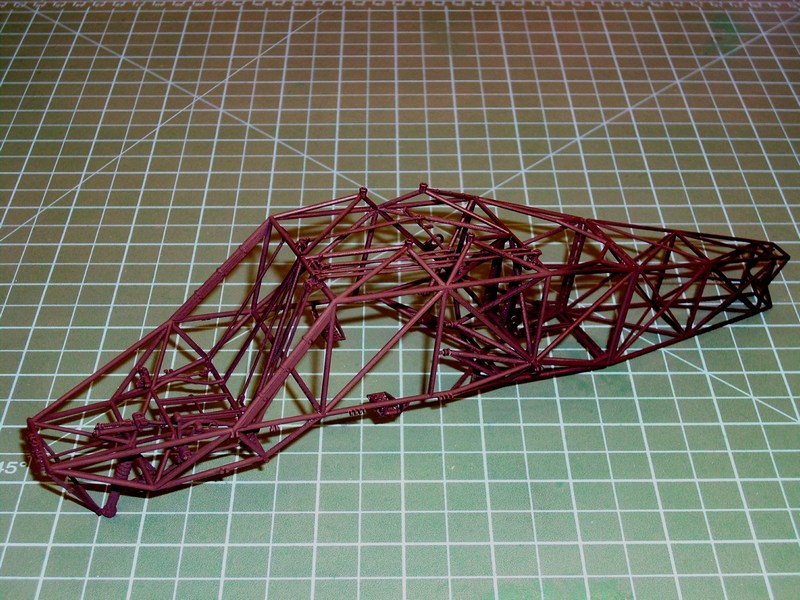
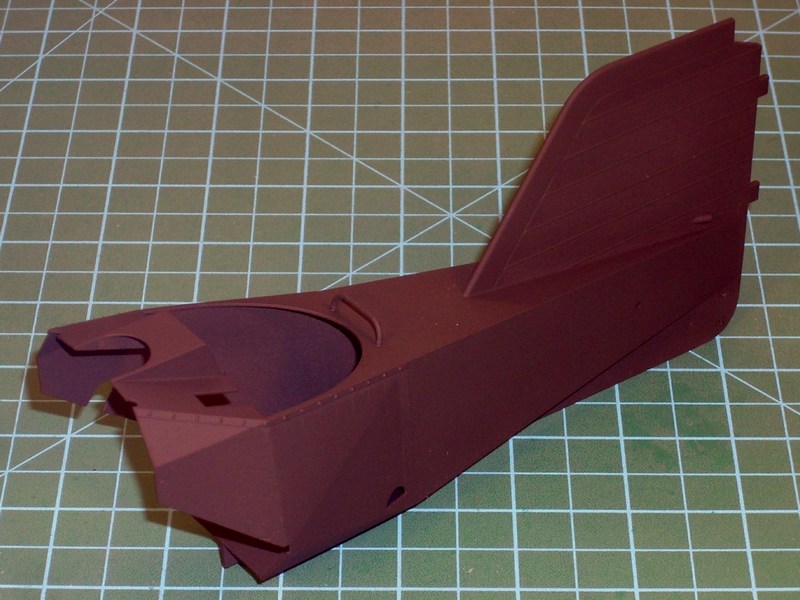 Düzenleyen Nick_Karatzides - 27/07/2018 Saat 12:19 |
|
 |
|
|
Nick_Karatzides
Üye 

Kayıt Tarihi: 06/06/2009 Aktif Durum: Aktif Değil Gönderilenler: 250 |
  Gönderim Zamanı: 01/02/2016 Saat 13:09 Gönderim Zamanı: 01/02/2016 Saat 13:09 |
|
Having succeeded (in her first airbrushing attempt) to spray black paint onto my clean & tidy hobby bench, I realized that it was time to urgently have a new spray booth for her, considering that my old one broke down after almost 15+ years of use. My initial thought to buy a brand new one, quickly dismissed when I found that the cheapest China-made spraybooth was quite small for my big-sized scale models and the purchase price could start from 100 and rise up to 500 or more. Additionaly, due to limited space on my hobby bench and the fact that I usually build big (close to huge) scale models, the spraybooth should be large enough to fit models inside, portable to keep clear the working bench when not in use and should be easily (and fast too) disassembled and stored under the bench.
Well, as a good friend once said, everything starts with a wish and inspiration can be found everywhere. I found the following item named Sortera which supposed to be a recycling bin with lid or something, at my local IKEA store. Looking exactly like what Ive been searching for and considering the low 15 price, I bought this 60 litres plastic box (IKEA product code is 702.558.99) and turned it into a paint chamber. Later, I also visited my local Leroy Merlin home depot (located right next to the aforementioned IKEA) store, trying to find the right parts for the project, such as bathroom ventilating fans, outflow plastic tubes and electric wiring. I found two 125 mm diameter bathroom ventilator fans rated at 32 W, 10 dB, 150 m3/h each for only 11 each. The purchase cost for buying materials to build the DIY spraybooth was: - 2 x ventilators rated at 32 W, 10 dB, 150 m3/h each: 2 x 11 = 22 EUR, - 1 x paint chamber (Sortera recycling bin with lid from IKEA): 15 EUR, - 2 x PVC 125 mm Ø plastic tube 90° fittings & bezel parts: 3 EUR, - 1 x PVC 125 mm Ø plastic tube 50 cm long: 1 EUR, - 1 x common kitchen extractor hood filter: 1 EUR, - 1 x electric wiring 2 m long & switch: 2 EUR. The total ammount with all the hardware was 44 (approx $48). 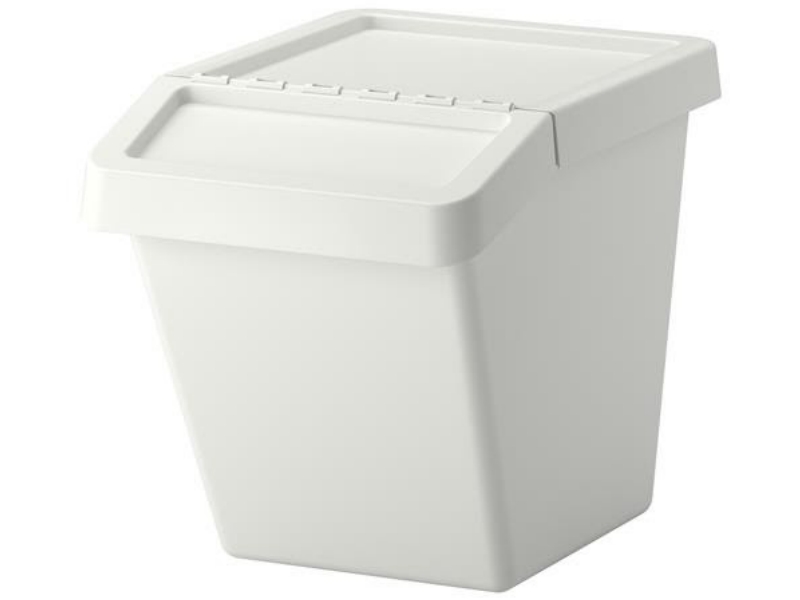 As soon as returned back home, I spent nearly one hour to assemble parts and make the scratchbuilt spraybooth fully functional. The first ventilator slided through the tubular wall opening (already existed for the previous broken spraybooth outflowing), secured in place and got wired to 220 V with a switch. The exterior wall opening is covered with louvers that automatically close when the ventilator fans are turned off, to prevent ingress of cold air in the room during the winter. Furthermore, when spraybooth is not in use, the inner wall opening is manually sealed with a proper cap. 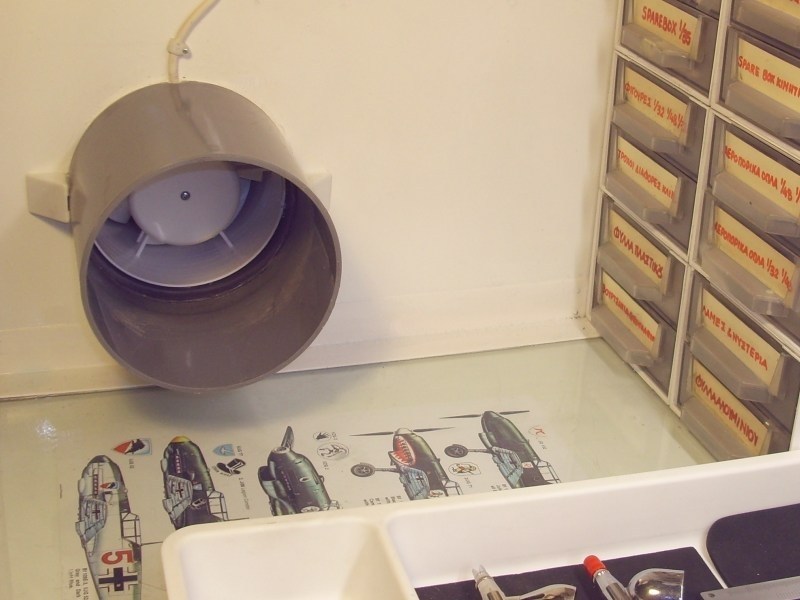
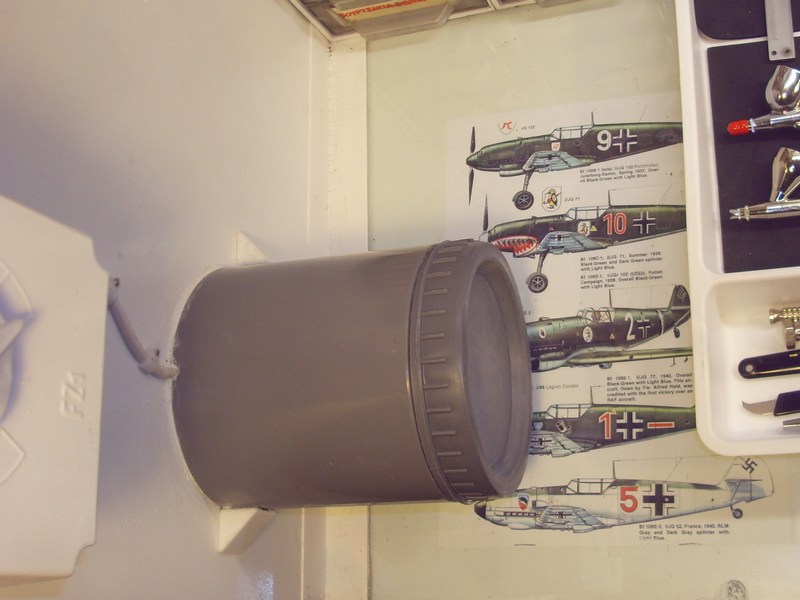
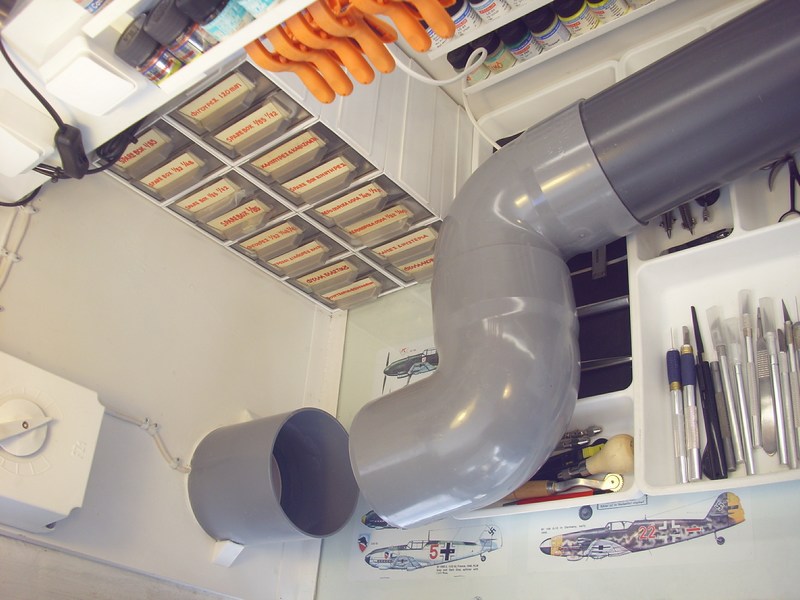 Later, the second ventilator mounted on a 125 mm wide drilled hole on plastic paint chamber side and connected to 220 V with seperate wire & switch. Between the two in-line-mounted ventilators (one located at the beginning and the other at the end of suction flow), a portable S-shaped 125 mm diameter tubing of total length 75 cm is inserted. At last, a common kitchen extractor hood filter installed, to prevent paint particulates entering into the airflow circuit. 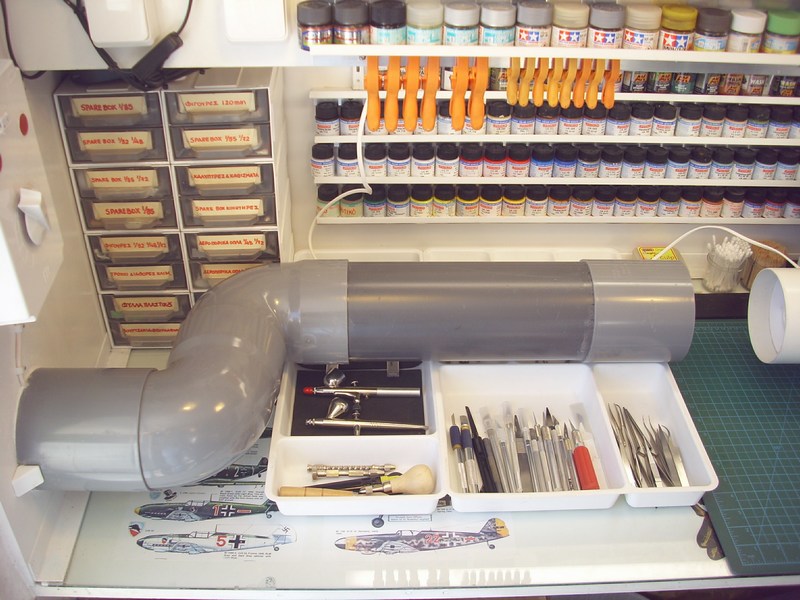
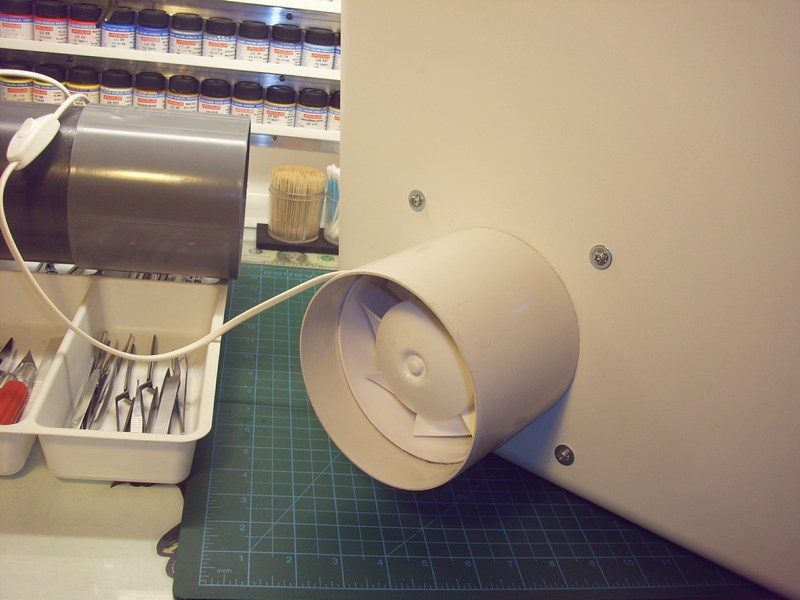
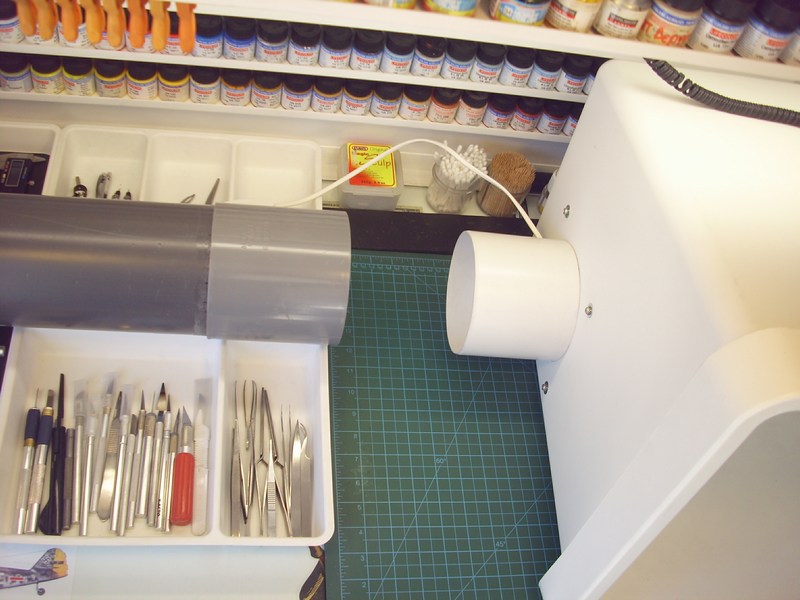 Düzenleyen Nick_Karatzides - 27/07/2018 Saat 12:20 |
|
 |
|
|
Nick_Karatzides
Üye 

Kayıt Tarihi: 06/06/2009 Aktif Durum: Aktif Değil Gönderilenler: 250 |
  Gönderim Zamanı: 01/02/2016 Saat 13:10 Gönderim Zamanı: 01/02/2016 Saat 13:10 |
|
As I later found out when first tested the spraybooth, the ventilators proved more powerful than expected, producing a suction flow of total 300 m3/h, meaning that (if my calculations are correct) the air inside the 60 litres paint chamber is renewed every 0.72 seconds. During the first airbrushing test, I noticed that the spray beam got warped (!!!) close to 90 degrees angle, towards ventilation fan and therefore I placed additional filters to reduce the airflow power.
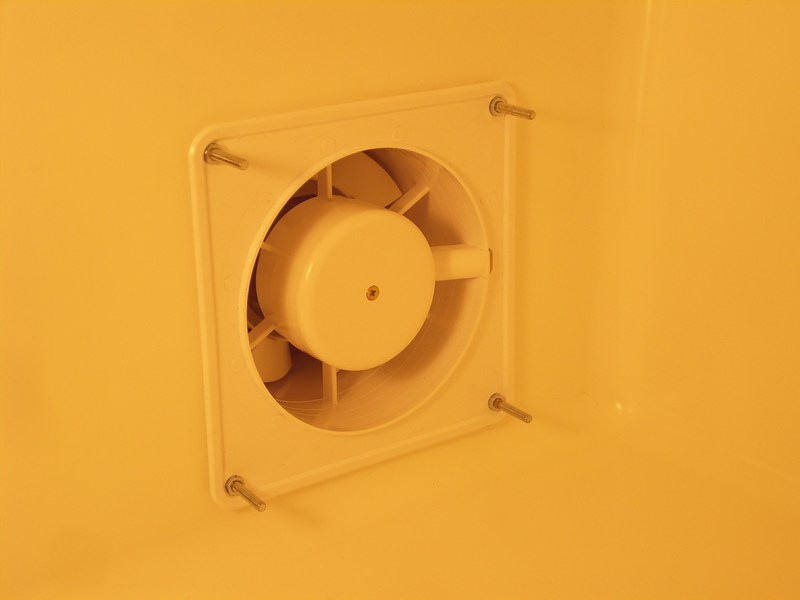
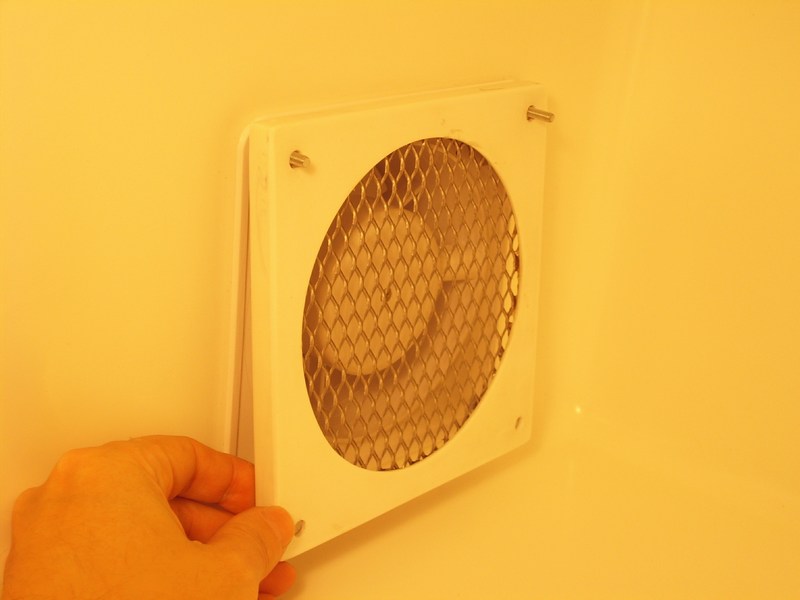
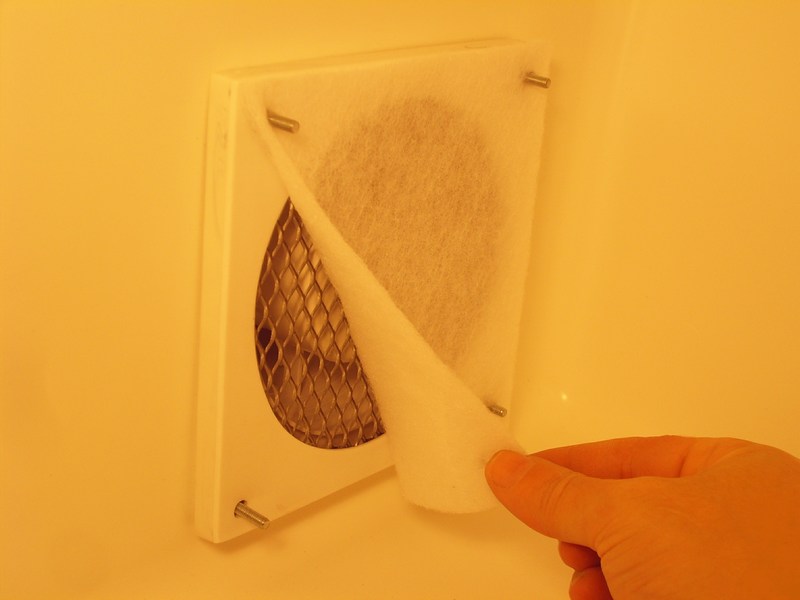
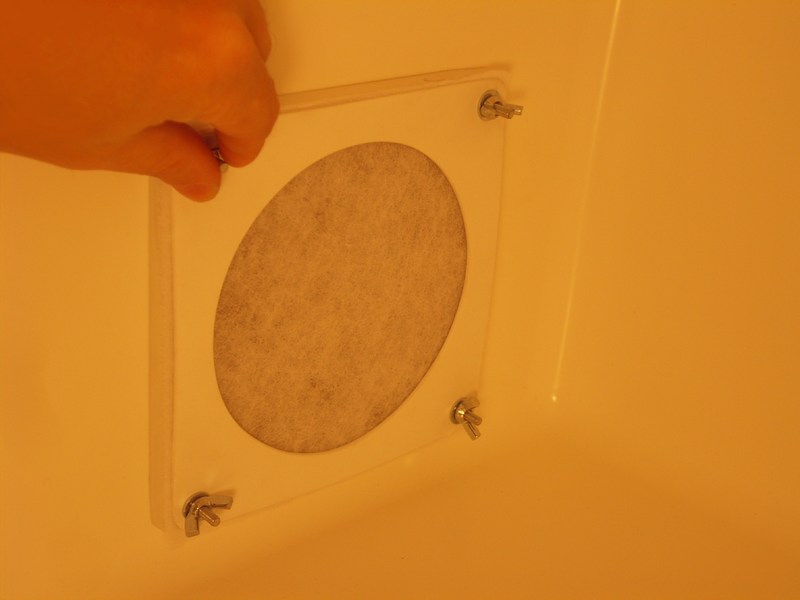 Long story short? My scratchbuilt spraybooth: - Cost me 44 EUR (approx $48 USD) to buy the hardware, plus one hour work to assemble parts & install electric wiring, - It has a 60 liters (measures 55x45x39 cm) paint chamber able to accommodate big-sized scale models, - It is almost operating silently, not exceeding 20 dB when both ventilator fans are in use, - It is fully portable (can be assembled or disassembled in less than 10 seconds) and - It sucks air like an inverted hurricane, even when filters are installed! 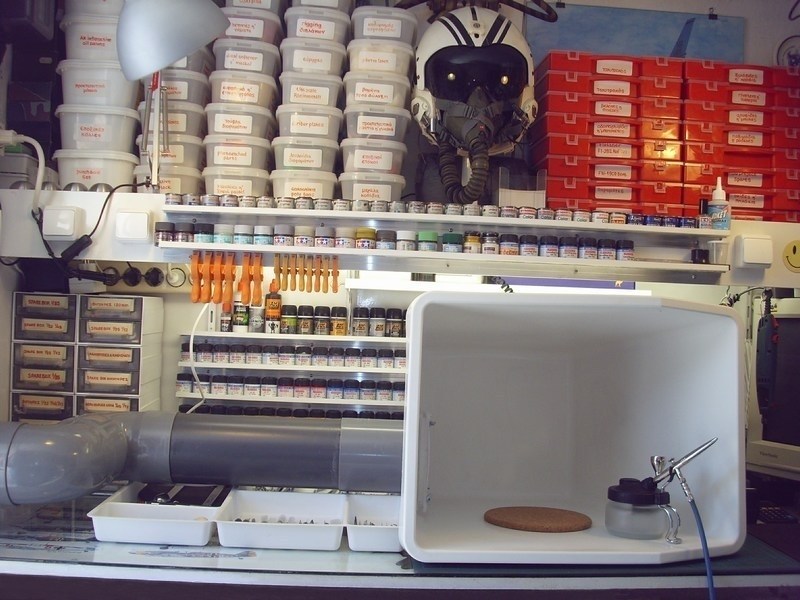
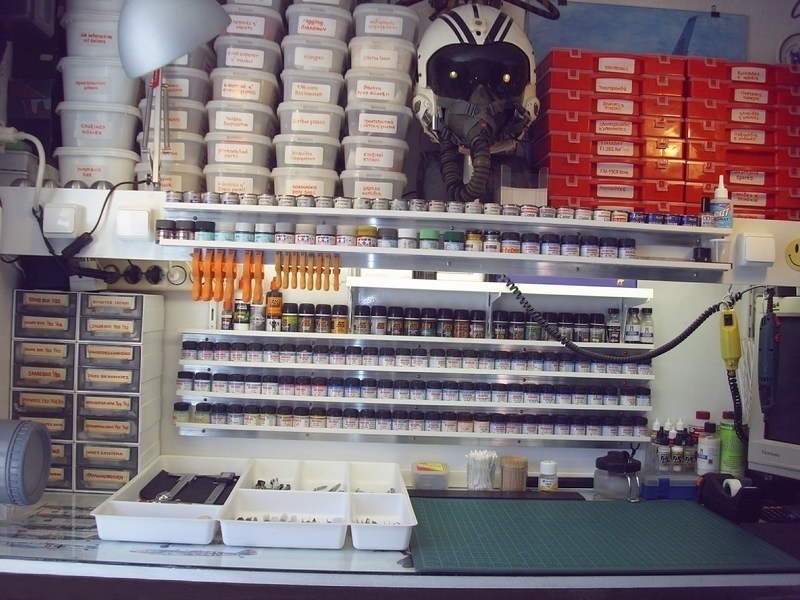 Having now a new fully functional & custom-made spraybooth, lets return back to to the painting process: All the 60 parts of the model kit, placed onto toothpicks for better handling while airbrushed and sprayed over with an overall mixture of 80% Life Color LC02 Matt Black and 20% Life Color LC37 Matt Burnt Umber acrylic as a primer, to prepare for the later paint layers. The toothpicks pinned onto cork sheet and parts allowed to dry. 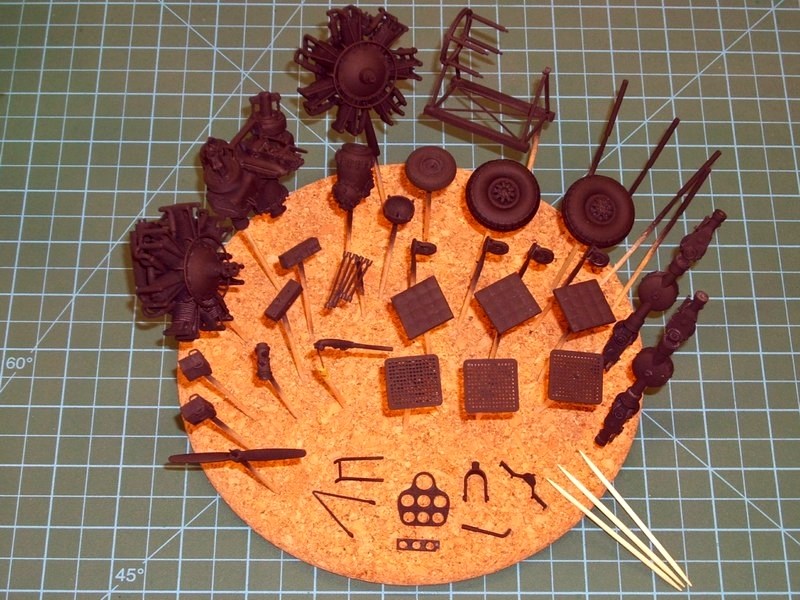 Behold the spraybooth filter, after 30 minutes of continuous black paint airbrushing into paint chamber. The use of this simple kitchen extractor hood filter kept the system clean. Double (or even triple) filter layer would be a good idea to reduce the airflow power in order not to warp the airbrush spraying beam (as previously described) and could ensure that components will remain spotless clean for a long time. If there was no filter at all, dirt & paint particulates would easily enter into the airflow circuit and stick onto the ventilator fans and the plastic tube inner walls. 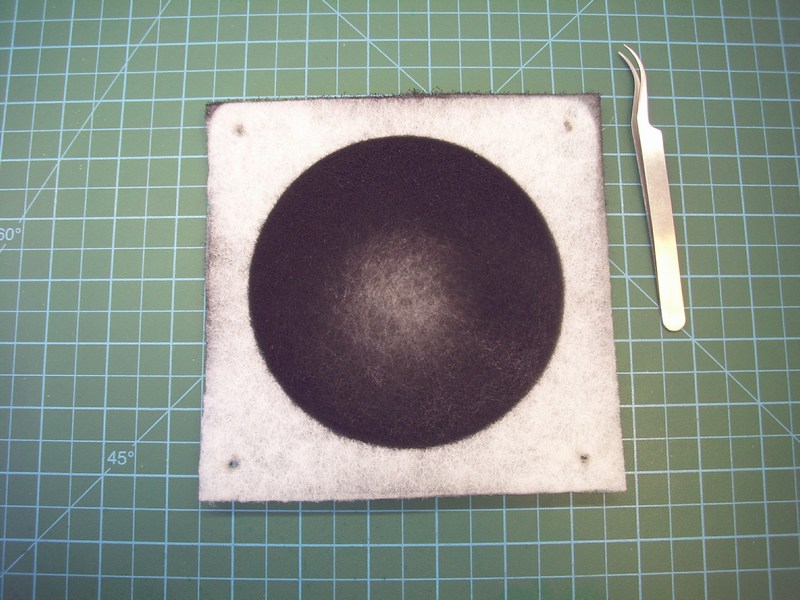 Düzenleyen Nick_Karatzides - 27/07/2018 Saat 12:22 |
|
 |
|
|
Nick_Karatzides
Üye 

Kayıt Tarihi: 06/06/2009 Aktif Durum: Aktif Değil Gönderilenler: 250 |
  Gönderim Zamanı: 02/02/2016 Saat 12:00 Gönderim Zamanı: 02/02/2016 Saat 12:00 |
|
The goal of modulation technique is to artificially enhance the model so the viewer sees more than what is really there. This is nothing new to us; figure modelers and 2D illustrators have been using this idea for years. Verlinden-era dry-brushing and even current post-shading trends dance around this same idea. To break it down even further, the fundamental theory of modulation effect is based upon using a singular light source, and the level to which you take this idea is inherently flexible. One of the beauties of the technique is that you can add a little, or a lot of it to your model.
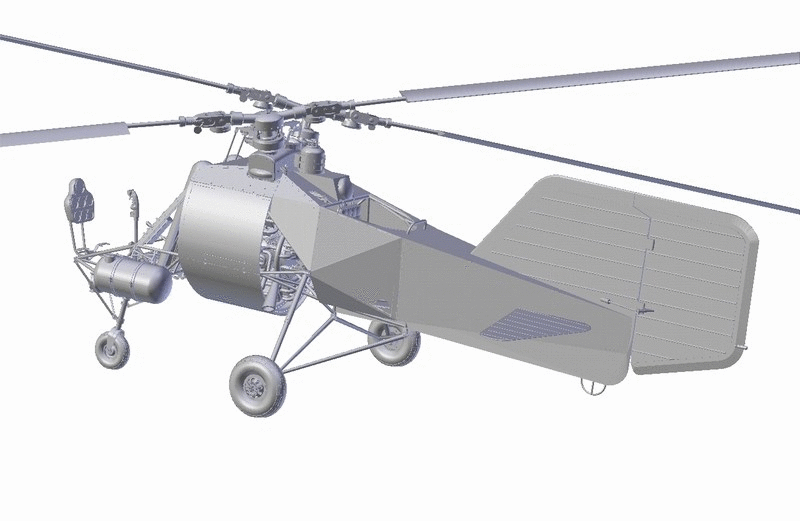
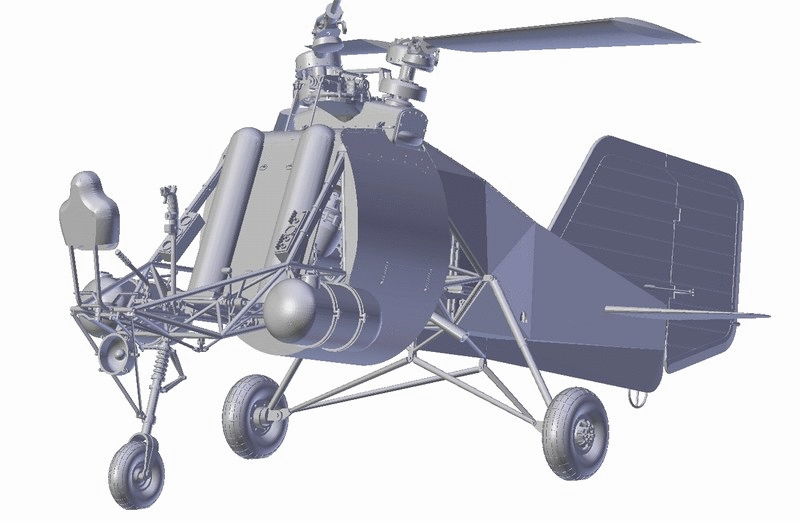
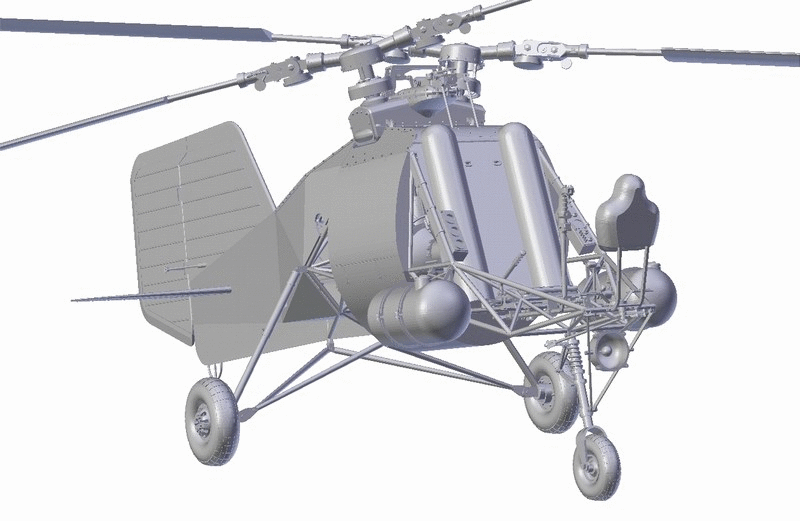
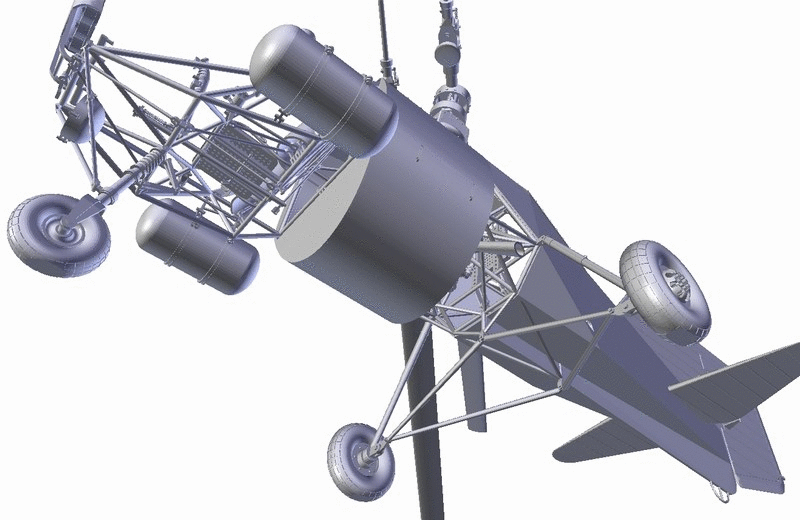
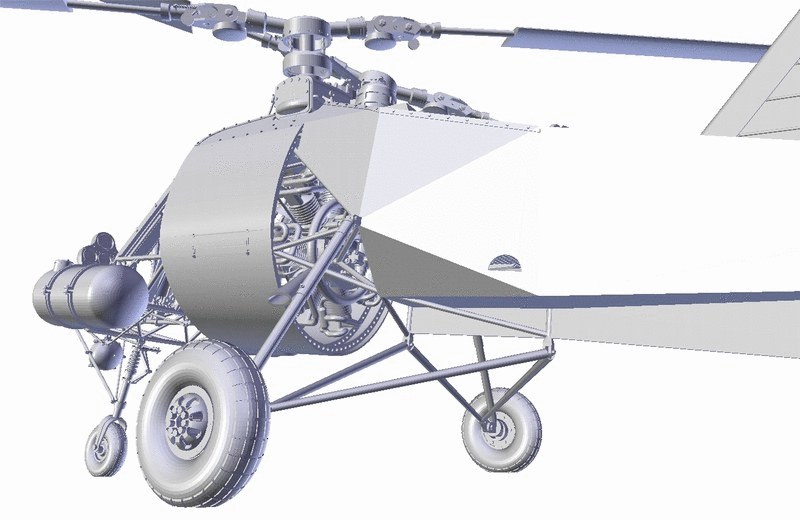 Modulations effect requires three main levels of color (light, medium and dark) to achieve proper gradations between the values, which are broken into stages as you lighten each progressive step. To do so, lot of airbrushing is required to add some just a little paint layer every time. First, I had to choose a source from which the lighter areas originate. I decide to keep it very simple and intend to have the light coming from the center upper frontal area of the helicopter and will also work well with the downward slope of the top areas. The basic processes and techniques involved are designed to enhance the 3D volumes and details of a model by playing up the balance between dark VS light, shadow VS highlights and so forth. Executing this goal is accomplished primarily with an airbrush by applying gradations of color to give the model more depth. Use of masking paint is essential, in order to focus the airbrush lighter colours spraying onto specific areas only. 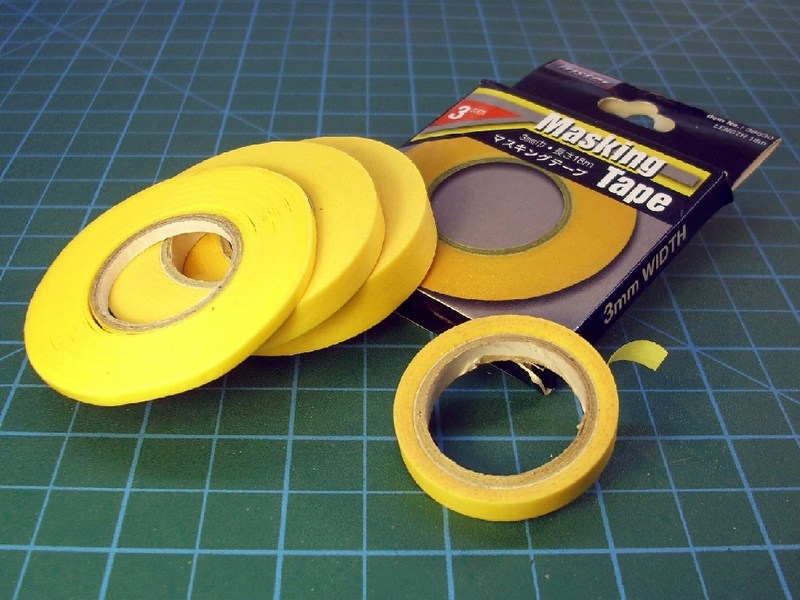 Because of the subject itself, the model is predetermined to have a base coat of dark green. Thus the first layer of color I apply is a coat of very thin Life Color UA502 Dark Green acrylic paint layer, very diluted with Life Colors acrylic thinner in a 30% paint to 70% thinner ratio. The darkest recesses sprayed first, gradually working my way up to the lighter upper surfaces. You can already see the intentional spray pattern developing from the darker lower right to the lighter upper left areas. I will maintain this pattern throughout the entire painting process to preserve continuity with the light source. 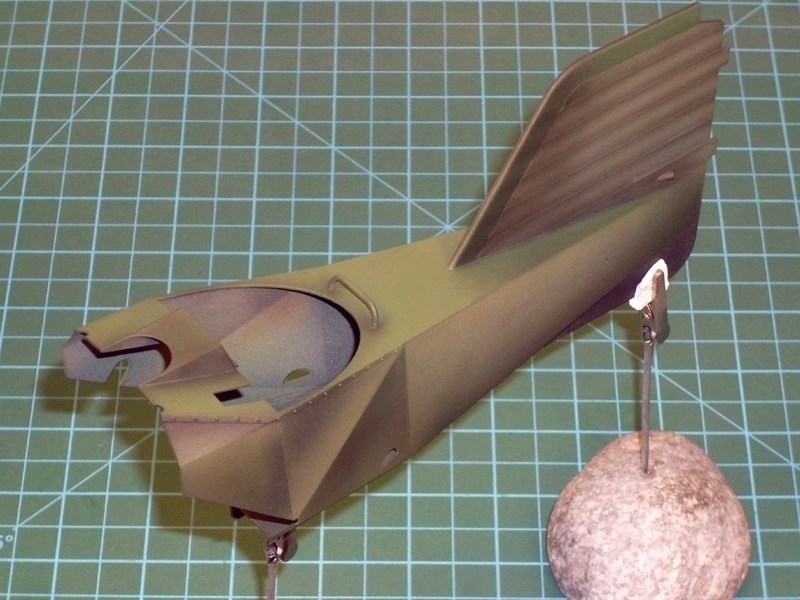
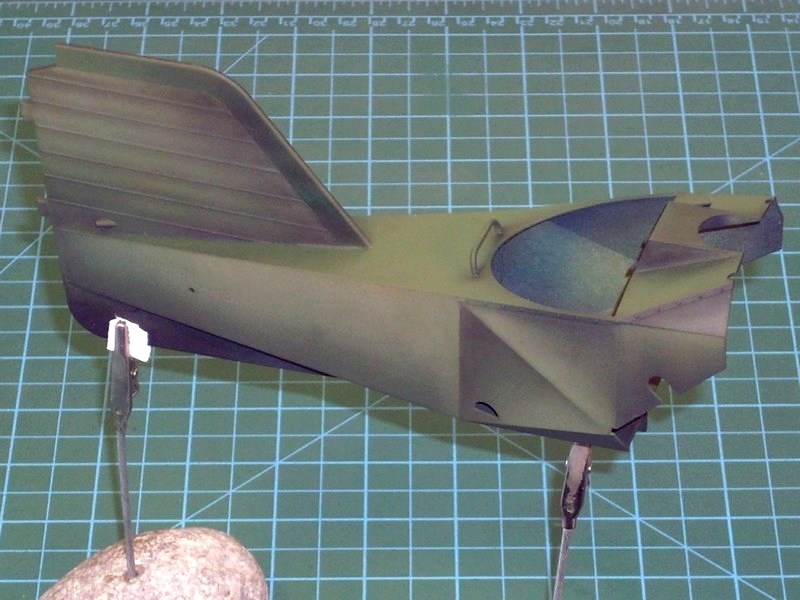 The subsequent spraying sessions will continue to utilize very thin Life Color UA502 Dark Green acrylic paint layers as a base to varying degrees because it is the source of the dark green. I will gradually lighten the model with each successive layer as the modulation painting process continues, so the second layer of Life Color UA502 Dark Green acrylic paint as the medium layer of the base coat, is based upon a less diluted 50% paint to 50% thinner ratio. Note that the darker lower areas receive less paint as the shades are carefully blended together, as seen above. Then, I add just a few drops of Life Color UA081 Sand Yellow FS30257 acrylic paint into the mixture to lighten up this stage of paint application, being very careful to always follow the established gradation pattern. The contrast between light and dark is now starting to become more apparent here. 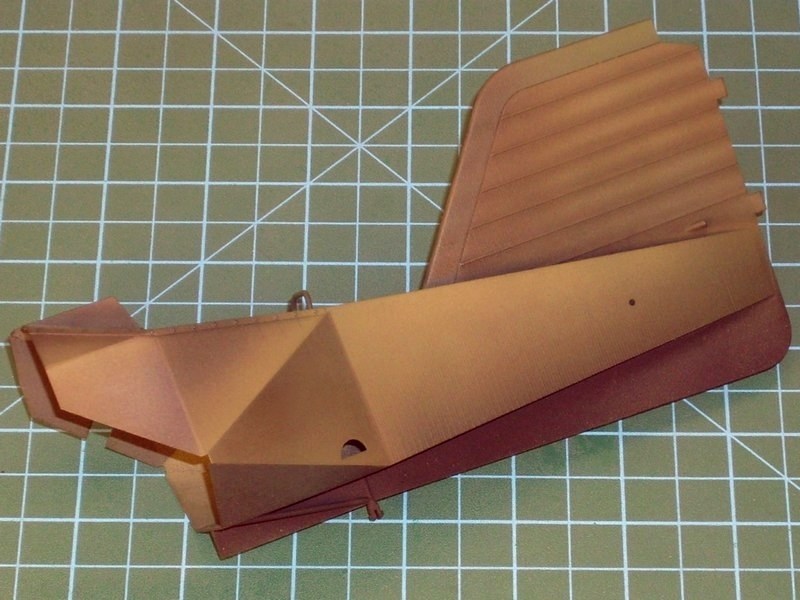 Following same painting procedures, all additional kit parts got some basic Life Color UA502 Dark Green and Life Color UA503 Light Blue acrylic paint and then gradually lighten up or became darker as required. As usual, painted parts placed onto toothpicks for better handling during airbrushing and later pinned onto cork sheet while allowed to dry overnight. 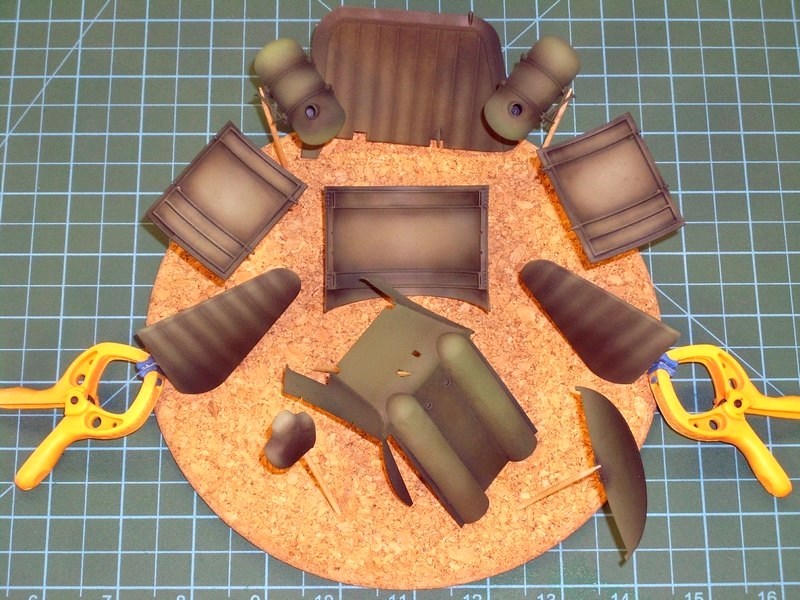 Düzenleyen Nick_Karatzides - 27/07/2018 Saat 12:22 |
|
 |
|
|
Nick_Karatzides
Üye 

Kayıt Tarihi: 06/06/2009 Aktif Durum: Aktif Değil Gönderilenler: 250 |
  Gönderim Zamanı: 05/02/2016 Saat 17:30 Gönderim Zamanı: 05/02/2016 Saat 17:30 |
|
Most of the FL-282 related WWII era pictures reveal that the fuselage truss-type welded steel tube frame on the Kriegsmarines early helicopters was painted light grey colour, following the general idea of the RLM 63 Light Bluegrey on fuselage fabric cover. On the other hand, the Luftwaffes Kolibris seem to had the fuselage steel tube frame painted in some dark colour (RLM 71 Dunkelgrün?) following the doped fabric cover designations. However, it is noticed that few Luftwaffes helicopters were appeared once to have the fuselage steel tube frame painted with dark green colour and later with light grey or even having a frame which individual tubes were painted in different colors. This might have happened due the fact that the Kriegsmarines helicopters later received by Luftwaffe kept original grey frame colour and just paint the doped fabric cover only or because the damaged helicopters were used as a source of spare parts for the remaining Kolibris. A fellow scale modeler from UK, sent me a photograph showing the actual Flettner Fl-282 V20 helicopter frame relic as seen at Midland Air Museum on September 25th 1987, before maintenance crew attempts to restore it into normal condition. Although the helicopters frame looks in bad condition, it is easy to observe that it was painted with at least three or four different colours. Ofcourse, I cannot be sure if this was the actual appearance of Luftwaffes operational helicopters during WWII or if it is a result of poor maintenance, corrosion or even vandalism. Anyway, as long as we accept that the apparently light blue & light grey colours are WWII Luftwafe authentic and not some post-War overpainting job, the picture is a valuable reference source and offers a general view of the paint used on the fuselage & undercarriage frame. 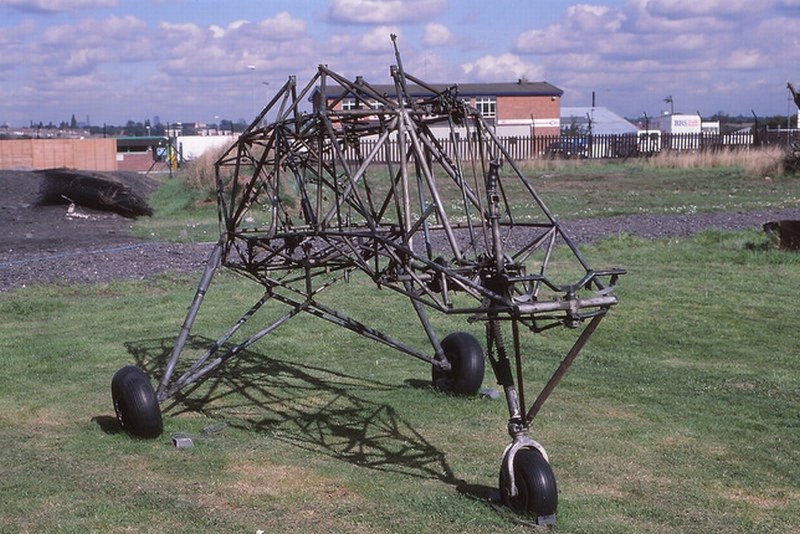 Because of the subject itself, the model is predetermined to have a base coat. Thus the first layer of color I applied was a coat of very thin Life Color UA503 Light Blue acrylic paint layer, very diluted with Life Colors acrylic thinner in a 30% paint to 70% thinner ratio. The darkest recesses sprayed first, gradually working my way up the frame, keeping to the lighter areas on central parts of each tubular part. Same pattern maintained throughout the entire painting process to preserve continuity with the light source and subsequent spraying sessions continued to utilize very thin Life Color UA503 Light Blue acrylic paint layers as a base to varying degrees because it is the source of the light colour. The tubular frame got gradually lighten with each successive layer as the painting process continued, so the second layer of paint as the medium layer of the base coat, is based upon a less diluted 50% paint to 50% thinner ratio. Note that the darker areas receive less paint as the shades are carefully blended together. Then, I added just a few drops of Life Color LC01 Matt White FS37925 acrylic paint into the mixture to lighten up this stage of paint application, being very careful to always follow the established gradation pattern, untill contrast between light and dark started to become apparent. 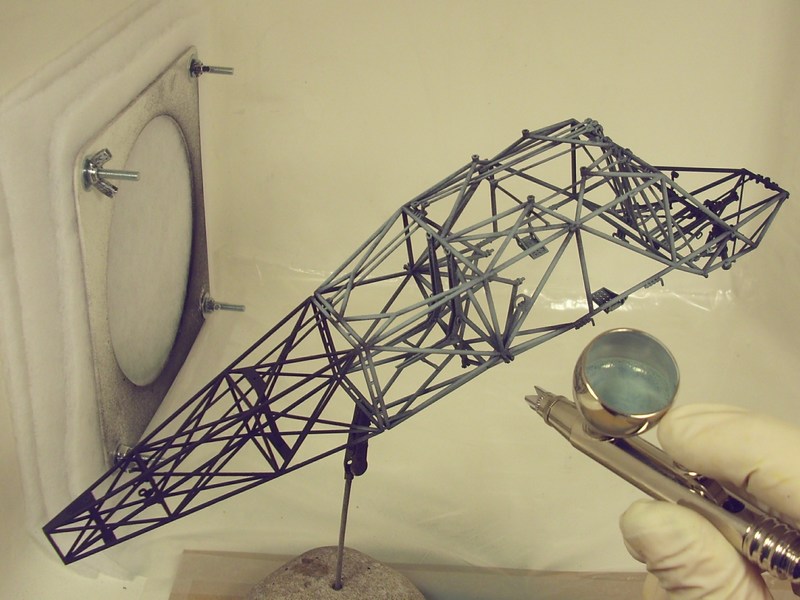
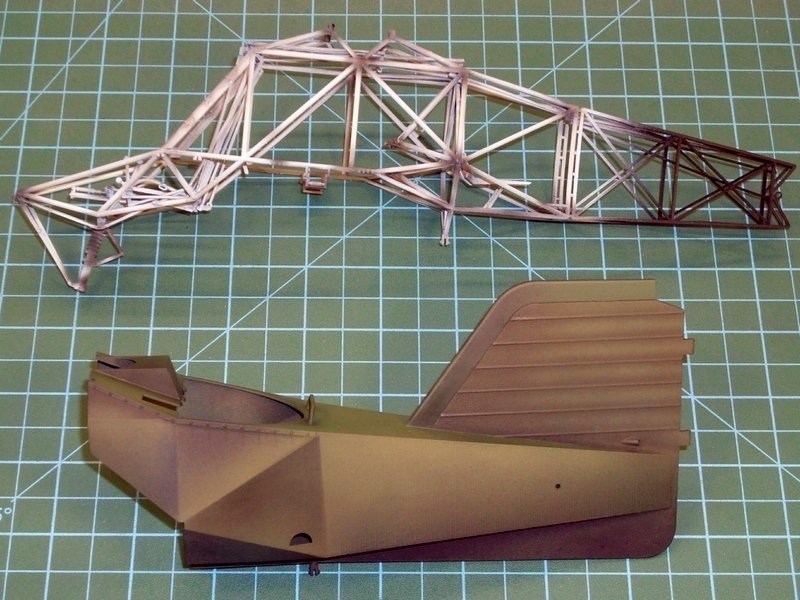 Following same painting procedures, each part (except the parts related to the engine and the drive transmitter) of the kit got some basic Life Color UA503 Light Blue acrylic paint and then gradually lighten up or became darker as required. The kit parts that were supposed to be painted in shades of wood, also got some acrylic base paint. As usual, each part placed onto a toothpick for better handling during airbrushing and later pinned onto cork sheet while allowed to dry overnight. 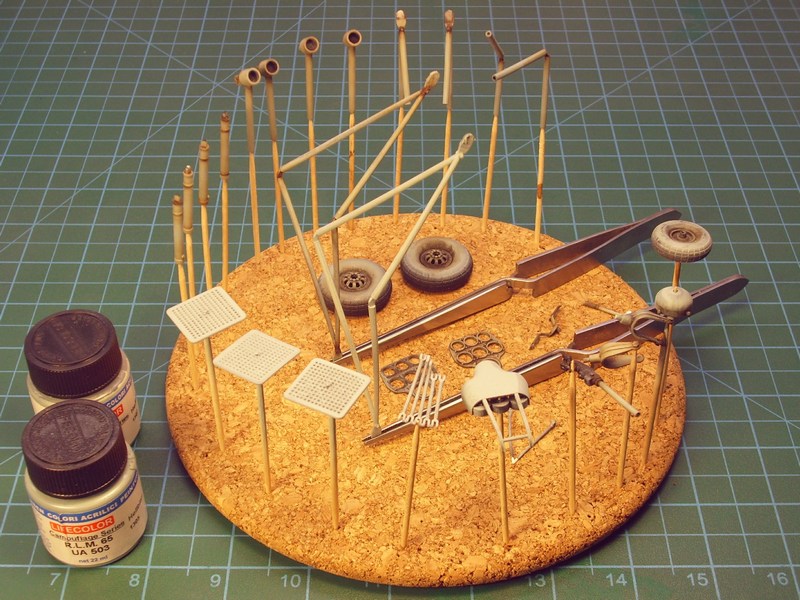 Düzenleyen Nick_Karatzides - 27/07/2018 Saat 12:23 |
|
 |
|
|
Nick_Karatzides
Üye 

Kayıt Tarihi: 06/06/2009 Aktif Durum: Aktif Değil Gönderilenler: 250 |
  Gönderim Zamanı: 06/02/2016 Saat 10:54 Gönderim Zamanı: 06/02/2016 Saat 10:54 |
|
Replicating wood is one of those feared tasks in modeling that many try to avoid at all costs. Having a couple of different methods in mind to simulate wood in scale, but knowing that the following method is much accurate and easier to re-do if something goes wrong, I found good idea to follow some tricks I learned from other builders and changing things that works for me. To simulate the look of rough wood from which was made the helicopters tail section frame, I split the areas to be painted in different categories and sprayed four different primary colors on each area. I used the following colors, which seemed to work OK for me. It is important to use an acrylic base colour because it is chemically impervious to the steps that follow.
- FS31643 available by Life Color as LC21 Matt Flesh Carnicino acrylic paint, - FS30400 available by Life Color as UA084 German Desert Yellow acrylic paint, - FS30257 available by Life Color as UA081 Sand Yellow RLM79VAR acrylic paint and - FS30140 available by Life Color as UA085 US Brown Marrone acrylic paint. 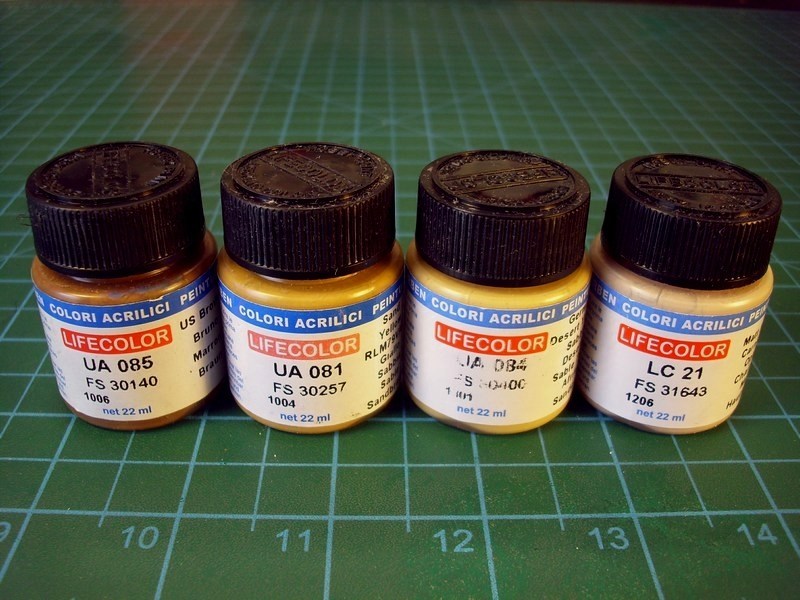 Because the wood composition and quality was not same everywhere, I also use the Life Color's Weathered Wood 6-pack set, of 22 ml bottles and repeatedly covered some areas with different shades of very very very diluted (10% paint to 90% thinner ratio) light layers over the previously applied base colours. To do so, I used the following: - Life Color UA717 Wood Cold light base acrylic paint, - Life Color UA718 Wood Cold light shade acrylic paint, - Life Color UA715 Wood Warm light shade acrylic paint, - Life Color UA716 Wood Warm light shade 2 acrylic paint, - Life Color UA714 Wood Warm light base acrylic paint and - Life Color UA713 Wood Warm dark shade acrylic paint. 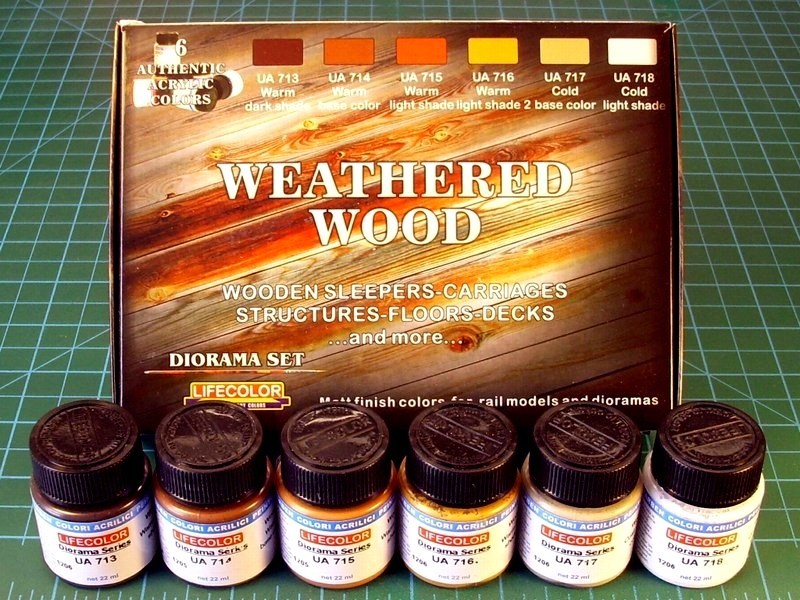 I'm not really sure if it is actually vissible into following pictures, but repeatedly applied very diluted & light layers, resulted more natural look of wood shades, without even aplly any oil colours yet. The first applied base colours, are visible under the later applied layers of the Weathered Wood shades, setting a base for the next process. As soon as paint dried, I repeatedly sprayed a very diluted mixture of thinner, Life Color UA717 Wood Cold light base acrylic and Life Color UA716 Wood Warm light shade 2 acrylic at a ratio of 90% to 5% to 5%, over selected areas such as the leading edges and a few other points, that should look more enlightened. 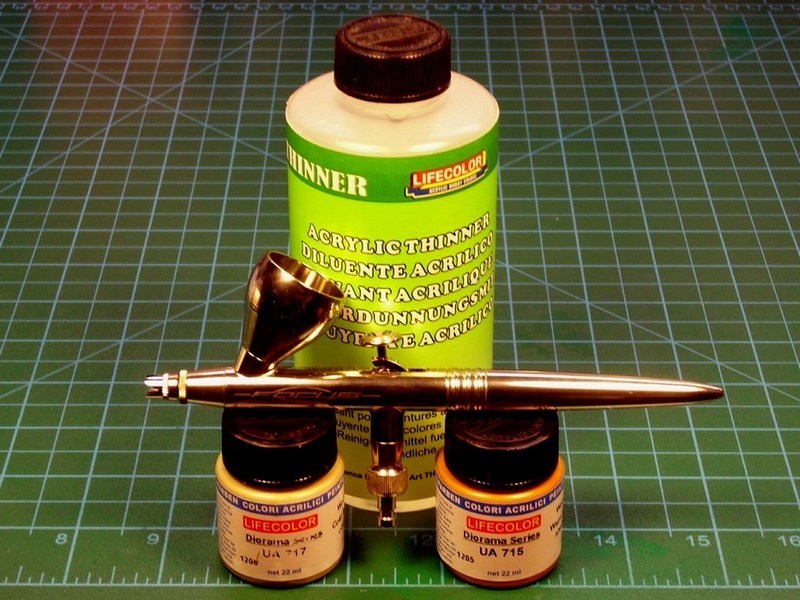 To apply the wood grain on wide areas covered with plywood, I used wood grain colour from artists oil paints. The higher quality artists grade paints work much better because the pigments are much more finely ground. I believe that 502 Abteilung by MIG Productions, Van Gogh and Talens are good brands. The colour of the background coat and the oils may be varied for different kinds of wood. However, be aware that selecting a good colour combination that gives that natural look is tricky. I recommend experimenting on a test piece first before committing yourself to apply the mixture on your latest wondermodel. I arrived at my blend of Burnt Sienna, Yellow Ochre and Raw Umber in a ratio of 25% to 25% to 50% after trying with Raw Sienna (too red), Yellow Ochre (too orange), and one or two mixed combinations. 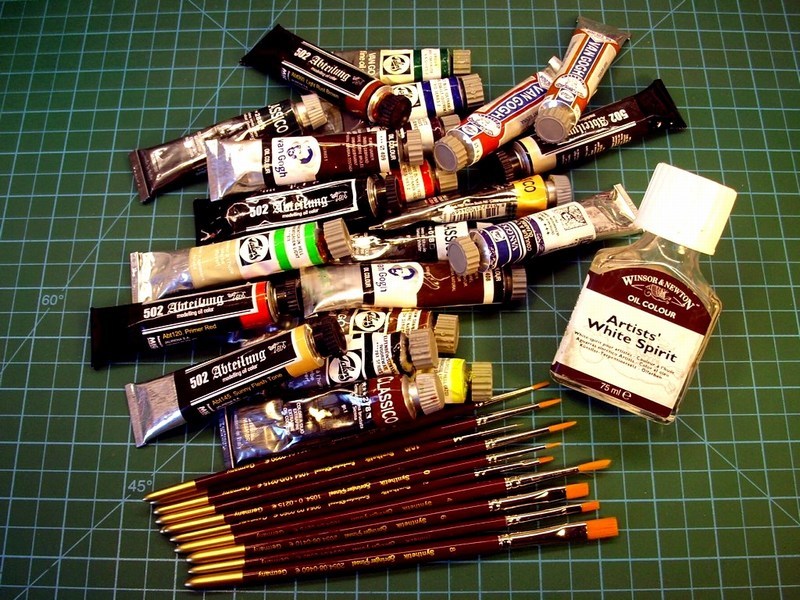
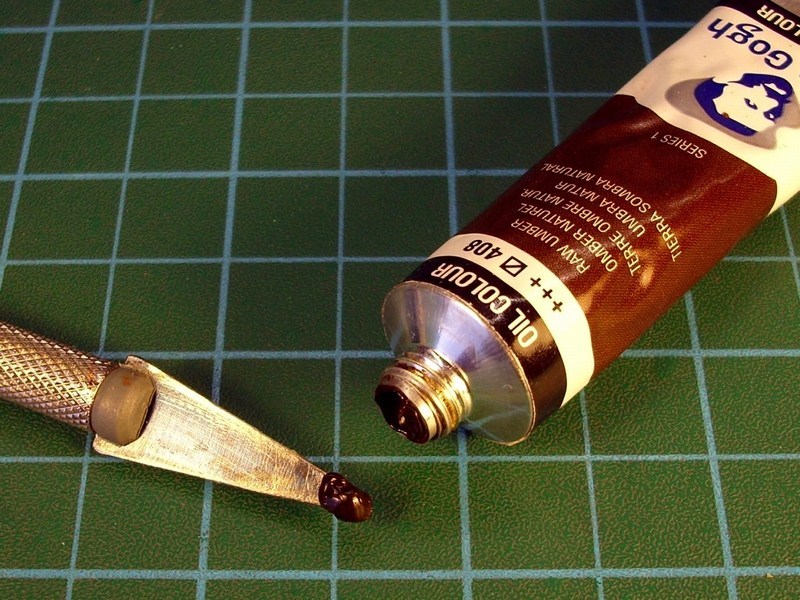
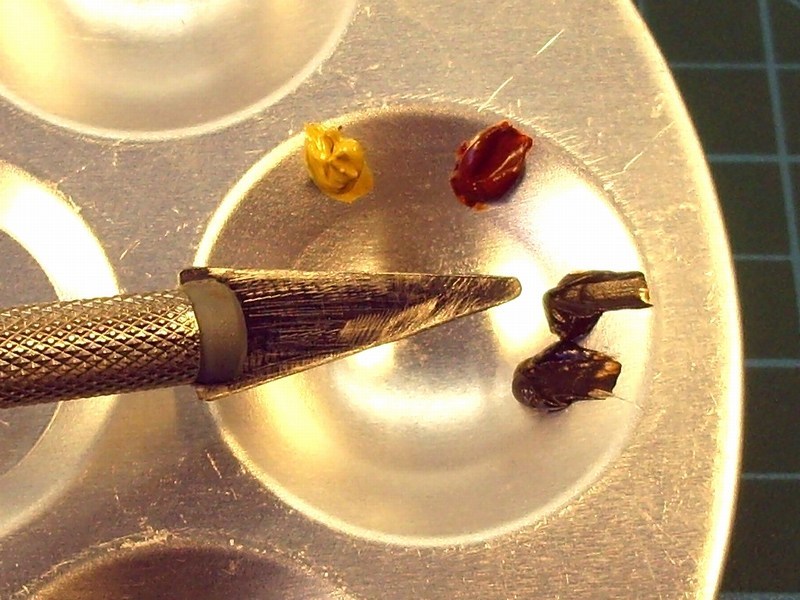 Düzenleyen Nick_Karatzides - 27/07/2018 Saat 12:25 |
|
 |
|
|
Nick_Karatzides
Üye 

Kayıt Tarihi: 06/06/2009 Aktif Durum: Aktif Değil Gönderilenler: 250 |
  Gönderim Zamanı: 06/02/2016 Saat 10:54 Gönderim Zamanı: 06/02/2016 Saat 10:54 |
|
Once the base coat has cured, I brushed the oils with a broad, soft brush and spread the paint around until the desired colour density is achieved. Because working in oils is a little bit goes a long way, I started by putting just a little bit of paint on the end of the brush. I kept the brush strokes going in one direction and didnt really worry about leaving brush strokes - I wanted them there for the wood grain. I tried not to spread it on too thick, or it would make the next step more difficult.
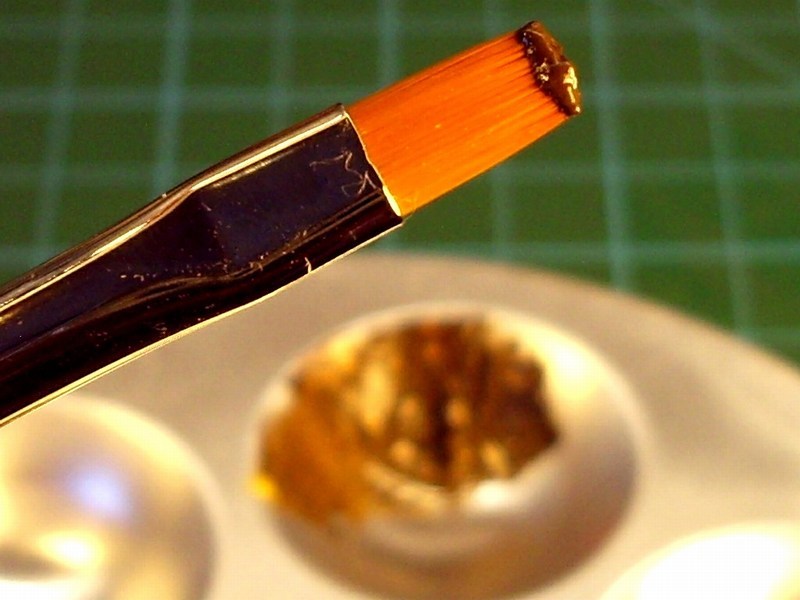 At this point the oils would be workable for several hours. With a broad, soft, clean and completely dry paint brush, I draged over the oil paint, leaving wood grain streaks. I jiggled the brush every now and then to give the grain a bit of variation. As the brush picked up the paint, I wiped it off on a clean, lint free cloth and continue process. Lint free is the key phrase, as any speck of lint would adhere to the oil paint and destroy the finish. The beauty of this technique is that you can clean the oils off and try again if you goof up. Use a clean cloth and paint thinner (mineral spirits or turpenoid - not lacquer thinner) to wipe clean any mistakes and start over again. For the 1/18 scale Kolibri helicopter frame, it took me about two or three tries to get the paint density and colour right, but it really was quite painless. 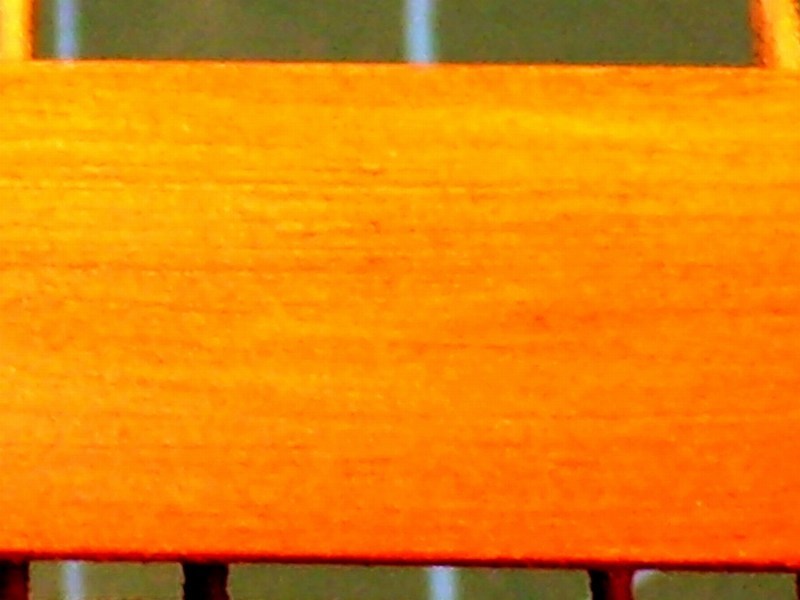 In some parts of the model which should look more bright, I slightly toned up with "Buff" & "Yellow Ochre" mixtures, or even pure Basic Flesh Tone" and Sunny Flesh Tone", while some others had to show darker, using "Brown" or "Raw Umber" color and blend naturally. Meanwhile, I tried same painting procedures on the wooden 3-steps ladder (used by Luftwaffe WWII ground crews and technician personnel for ground vehicle & aircraft maintenance procedures), which also got CAD designed & 3D printed with the helicopter kit parts to be used as a diorama accessory. 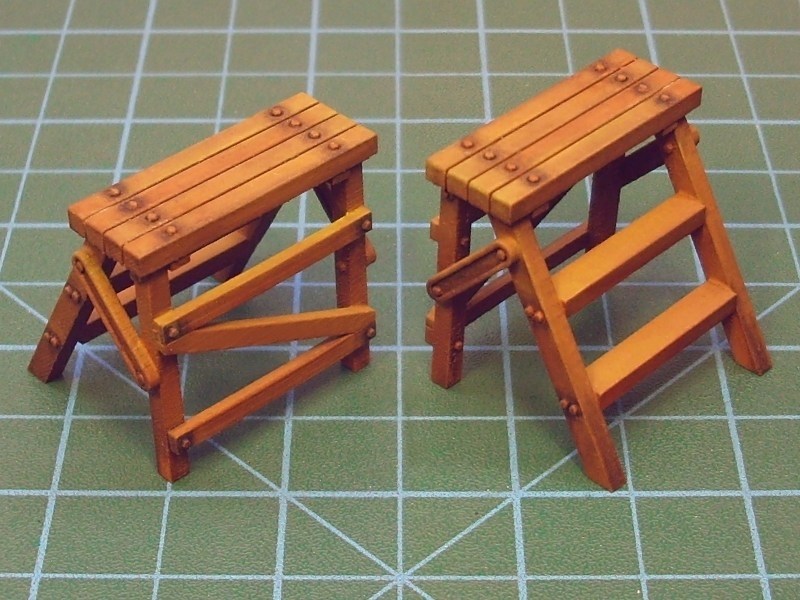 As soon as the result was OK for me, I left it alone to dry for few days and then sprayed over selected areas with Tamiya Color X-24 Clear Yellow acrylic, because it also helps bring the grain color out more. 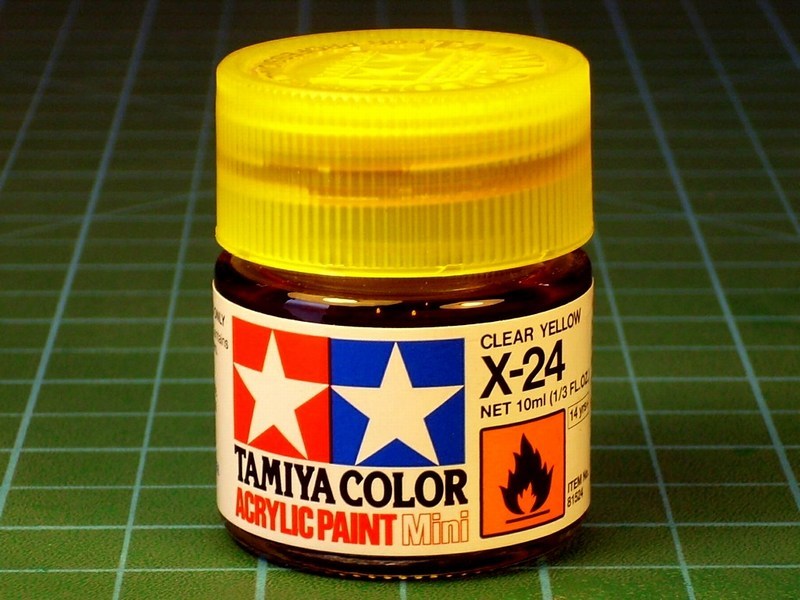
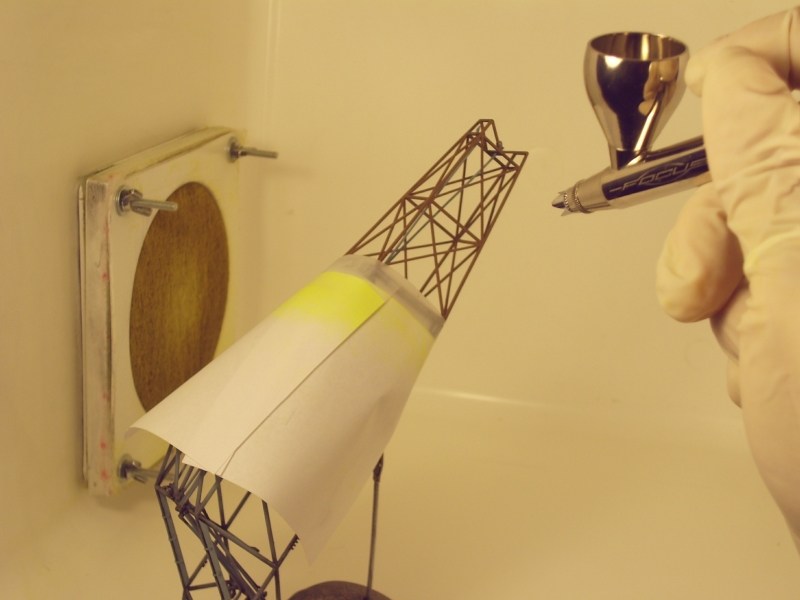
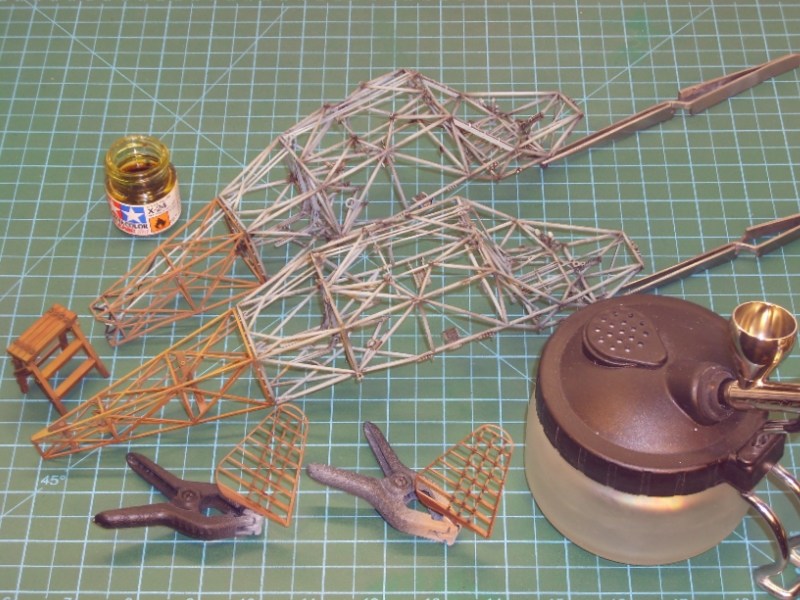 Düzenleyen Nick_Karatzides - 27/07/2018 Saat 12:26 |
|
 |
|
|
Nick_Karatzides
Üye 

Kayıt Tarihi: 06/06/2009 Aktif Durum: Aktif Değil Gönderilenler: 250 |
  Gönderim Zamanı: 09/02/2016 Saat 20:23 Gönderim Zamanı: 09/02/2016 Saat 20:23 |
|
In recent years, most scale model companies avoid (for political correctness reasons) to depict the swastika symbol on kit box and the water slide decal film. In addition, some scale modelers fear of some mighty Holly Inquisitorial Court and remove or misquote the swastika symbol from their plastic aircraft models when present them on exhibitions, contests, magazine articles and hobby related forums around the internet. Since I strongly believe that scale modeling is not a political statement, but rather a source of Historical information, I do not intend to follow the hiding-the-truth hypocritical behaviour that starts to occur around the scale modeling community nowadays. Scale modeling is used for purposes of civic education, protection against anti-constitutional activities, scientific and military History research and reference for aviation enthusiasts. The swastika symbol stigmatized as being associated with German Nationalist Aryans sick wishes to conquer the World & dominate the Universe but it should never be forgotten, misquoted or deleted - it is a symbol marked a dark era of human History. Nowadays, the swastika has been outlawed in Germany, proof that the Germans ashamed (once again) of their ancestors History. In short, building WWII Luftwaffe plastic aircraft scale models with the swastika symbol on tail or wings should not be misunderstood as expression of sympathy for any neo-Nazi or extreme right-wing groups. For all the abovementioned reasons, the swastika symbol will be clearly visible on my Fl-282 V21 scale model tail fin as once appeared on actual helicopter during the WWII. 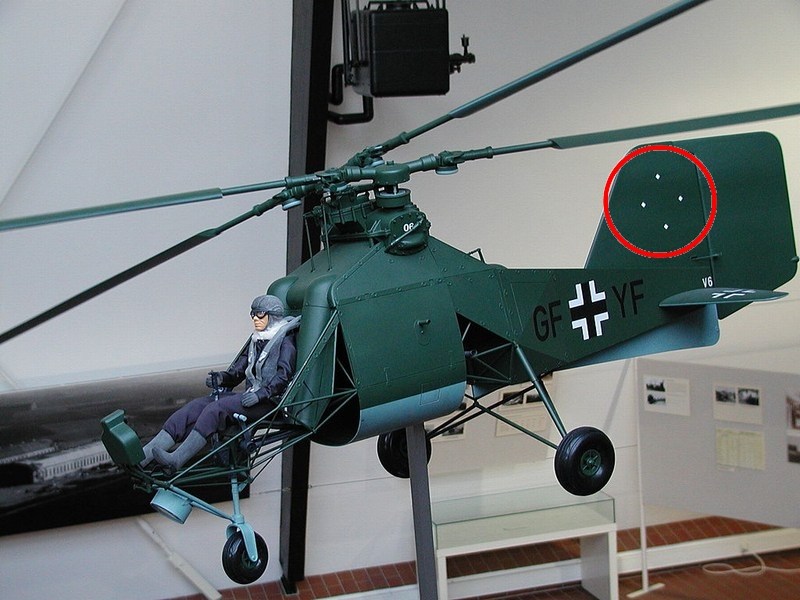 While surfing the net, I discovered someone who had an auction item, actually a WWII German aircraft relic, that is supposed to be part of Flettner 282 helicopter. He claimed that part (with balkenkreuz insignia on) was cut out by WWII veteran US Army PFC Donald R. Nankervis who sent it to his home back in States as a War trophy. According to the instructions written on the back of the canvas, the item was a part was taken from a German airplane stationed at Hittlers private airport at Ainring village between Teisendorf and Salzburg, Austria. Nowdays Ainring airport museum officials, confirm that the Flettner 282 helicopters were actually stationed there at that particular time period (7th May 1945) and used by the 3rd Reich authorities to serve Berchtesgaden & Berghof residence - this makes the story plausible enough and quite convincing, as far as the Historical data and dates. On the other hand, I have some doubts because at that time, all Kolibri helicopters were supposed to be painted with the Luftwaffe's RLM Green / Light Blue colours and not the Kriegsmarine's Grey. Im also puzzled as to why the US serviceman didnt cut out the entire stammkennzeichen marking, but I think that US soldiers were more interested for balkenkreuz & swastikas insignia trophies at this moment, because they symbolic represented the victory on the 3rd Reich. Possibly, the US troops didnt have in their mind that these items will become very valuable for collectors & scale modelers 70+ years later. Additionally, if the above mentioned sellers story is true, it turns out that the British troops were not the only ones who vandalized some one-of-a-kind (at that time) aircrafts, just to show to their friends & family back home that they fought Germans. Anyway, if the auction item is actually a genuine part of a Kolibri helicopter, the following pics are certainly valuable info, considering the rarity of helicopters color photographs. 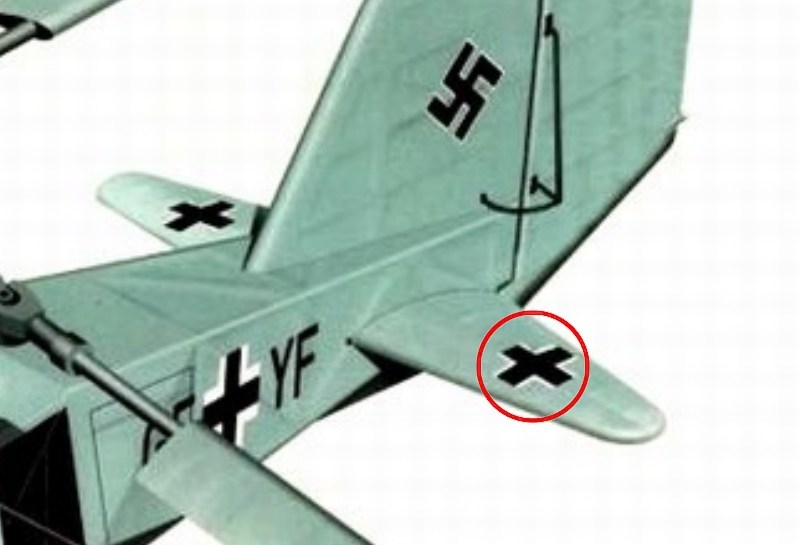
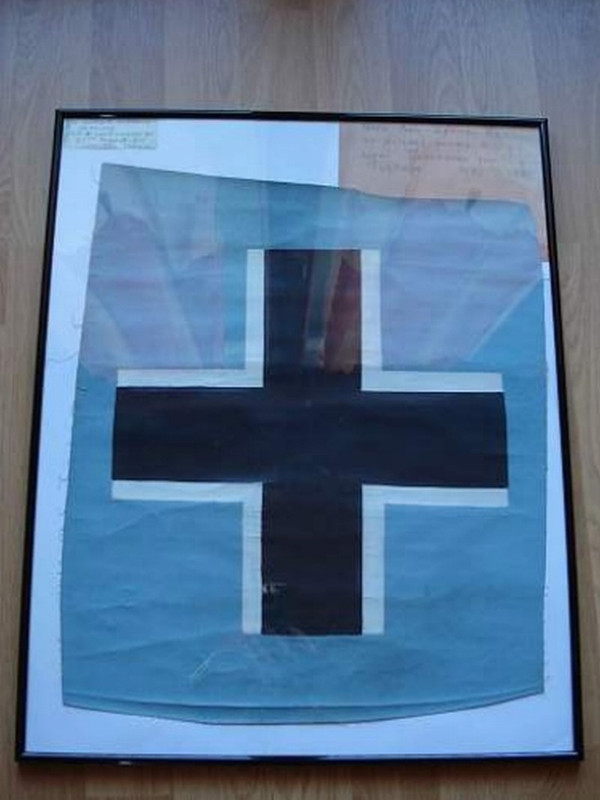
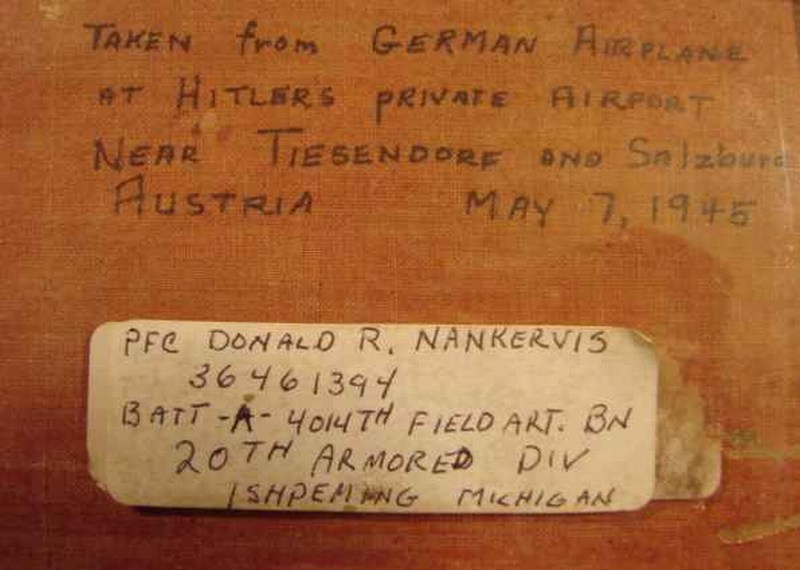
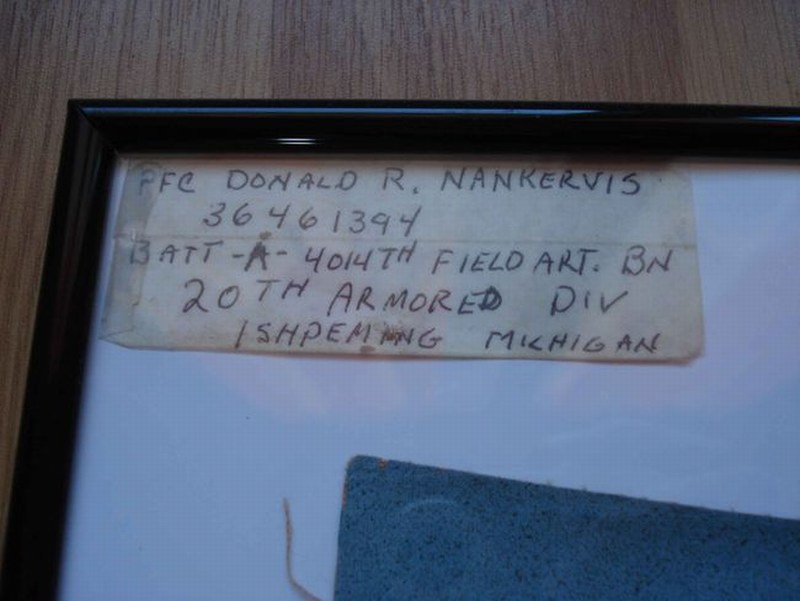 The first couple of 3D printed 1/18 scale Fl-282 helicopter models built by me as commision work on behalf of collectors, had the Kriegsmarines stammkennzeichen (four-letter factory radio code on the fuselage sides and repeated on the both elevator wings undersides), the balkenkreuz & swastikas insignia airbrushed on fuselage - a process that requires precision and careful masking. 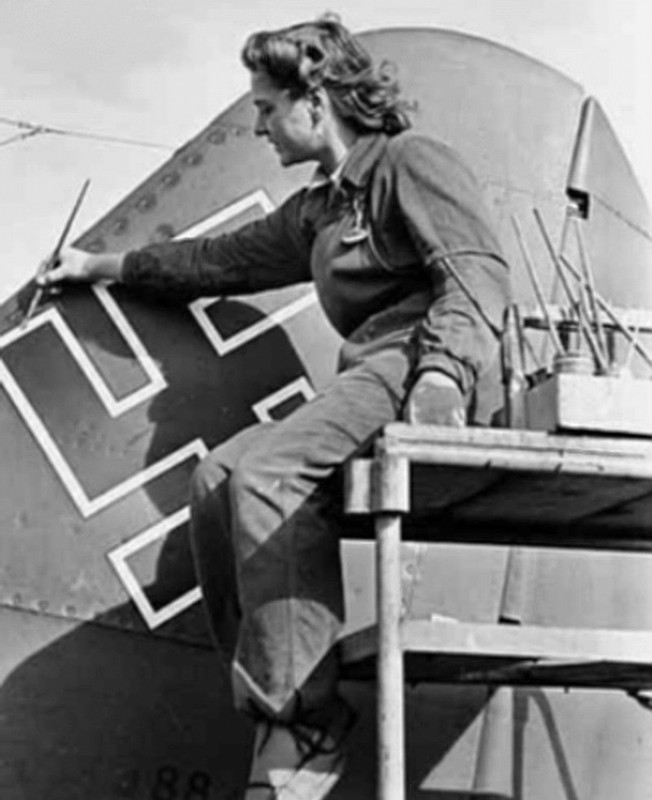 The airbrushed insignia might look nice on big scales when all the repeated masking & airbrushing layers are perfectly executed, but I am a lazy guy and I follow that the easier, the better motto. To do so, I designed the images on Corel, rescaled them on right dimensions and asked Mr. Triantafyllos Metsovitis, owner of LM Decals to print some right-in-scale Luftwaffe water slide decals for me. Yes, simplicity makes things flow without effort. Luftwaffe insignia print under exact dimensions for a 1/18 scale build, is included into the 102-page ultra-detailed 1/18 Fl-282 V21 kit building instructions manual which can be found HERE as a PDF format downloadable file. 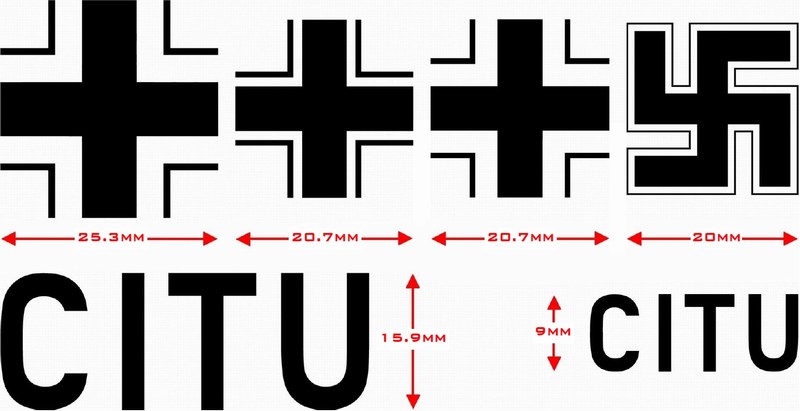
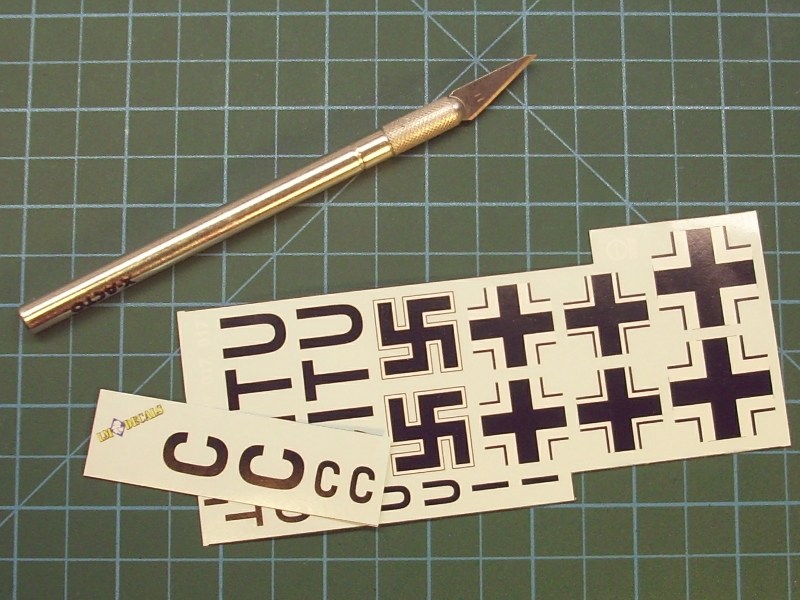 I used a soft brush to apply a light coat of Microscale MicroSol to soften the water slide decal and allow it to become part of the surface. As soon as the water slide decals were dry, an acrylic gloss coat applied to seal the result so far. Once the acrylic gloss coat has cured, I tried to wash the paint by brushing Winter Streaking Grime available by AK Interactive as AK014 filter, until the desired colour density is achieved. The outcome had tonality differences and looked like been highlighted by the sun while shades softly blend each other. Some of the wash mixture is re-applied and the wash being wiped completely out of the narrow points. 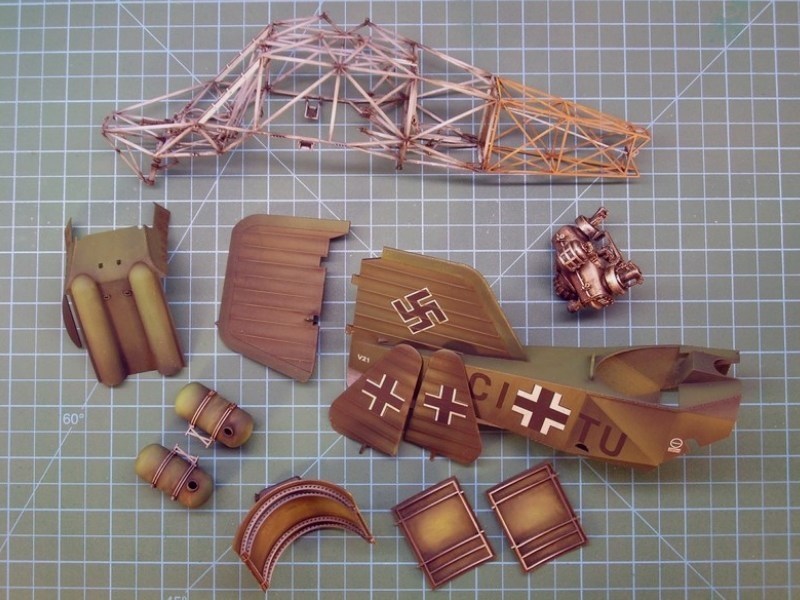 Düzenleyen Nick_Karatzides - 27/07/2018 Saat 12:27 |
|
 |
|
|
Jolly Roger
Üye 
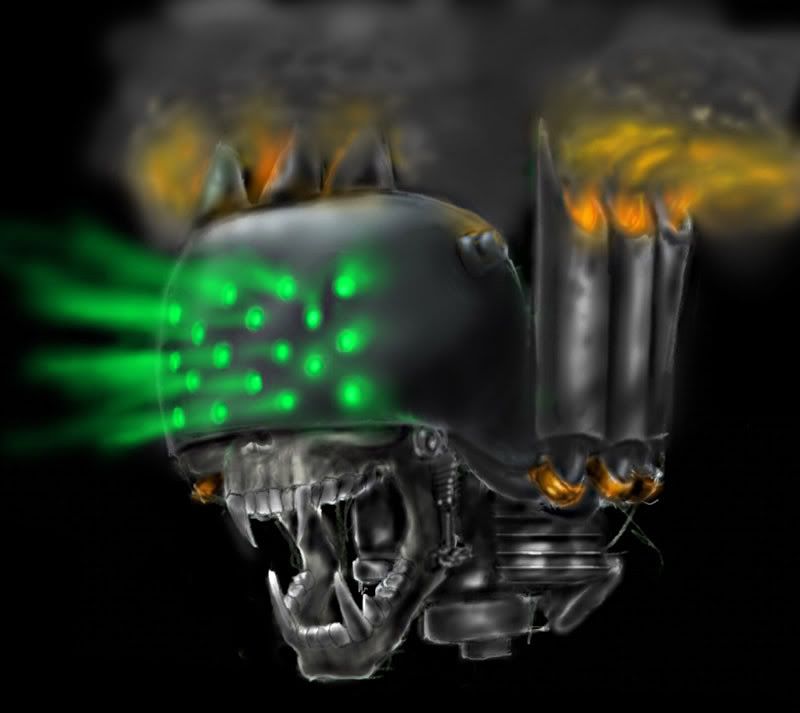
Kayıt Tarihi: 18/08/2005 Aktif Durum: Aktif Değil Gönderilenler: 2435 |
  Gönderim Zamanı: 10/02/2016 Saat 22:47 Gönderim Zamanı: 10/02/2016 Saat 22:47 |
|
I think my eyes hurt and my mouth is fairly dry at the same time drooling(not to the blond don't worry). Your work seriously makes me want to quit this hobby....ehehe hehehe....
|
|
|
Consume Ergo Sum
|
|
 |
|
|
Nick_Karatzides
Üye 

Kayıt Tarihi: 06/06/2009 Aktif Durum: Aktif Değil Gönderilenler: 250 |
  Gönderim Zamanı: 17/02/2016 Saat 03:25 Gönderim Zamanı: 17/02/2016 Saat 03:25 |
|
Setting as a task to build the model in such a way that all the maintenance hatches, removable doors, hoods & sliding panels would remain opened to make helicopters internal structure visible, building and later painting & weathering as required a 7-cylinder radial engine is something I should also take care of. Actually, the models observer can easily have a closer look inside the helicopters belly and also check detail on the - visible by any angle - engine details same time. Since the engine would be installed inside the helicopter's belly in the fuselage center-section, a second engine also 3D printed to be placed onto a wheeled stand and present it nearby helicopter, as it would be there for maintenance purposes - just a diorama scene idea. These two engines are almost identical with only difference that the first one is designed to fit into the helicopters transmission unit, while the second is equiped with a bezzel to fit a propeller and is designed to be displayed on the wheeled stand. For those who might be interested, both 7-cylinder radial engines are available HERE as 3D printed models under 1/16 and 1/18 scale, with or without the wheeled stand. 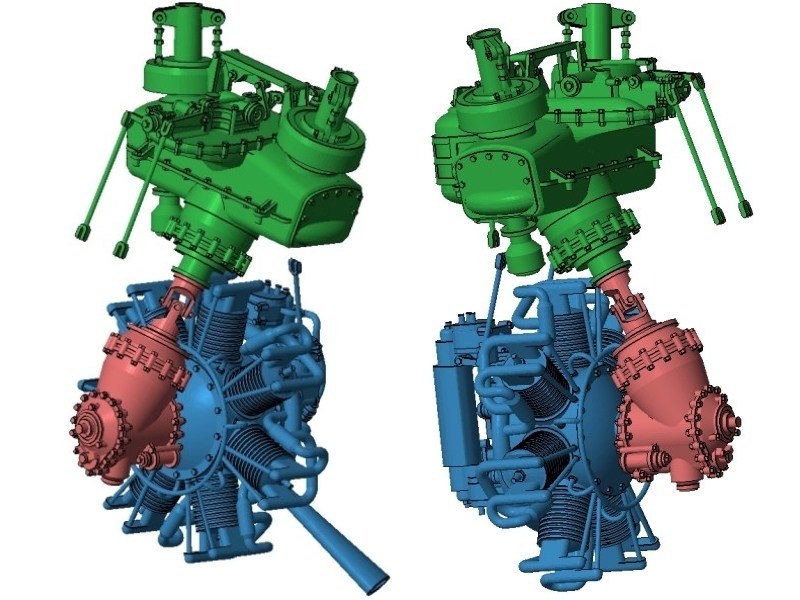
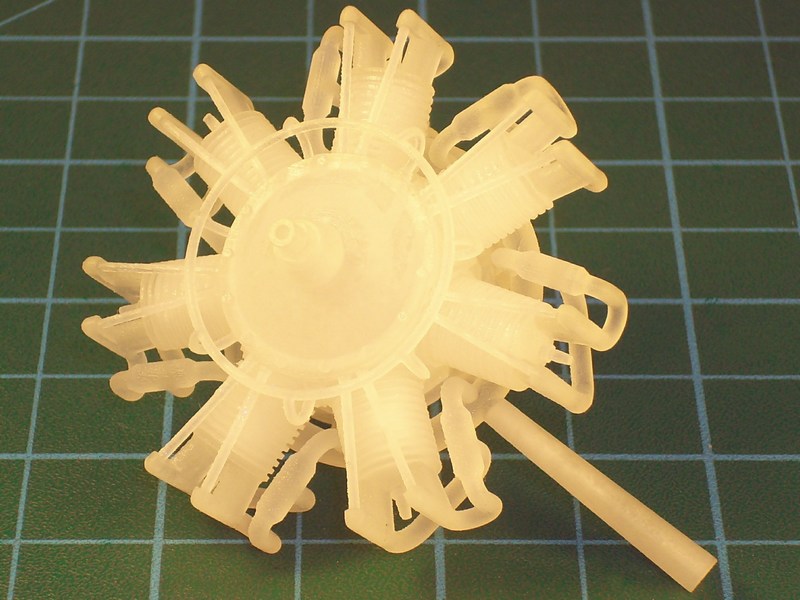
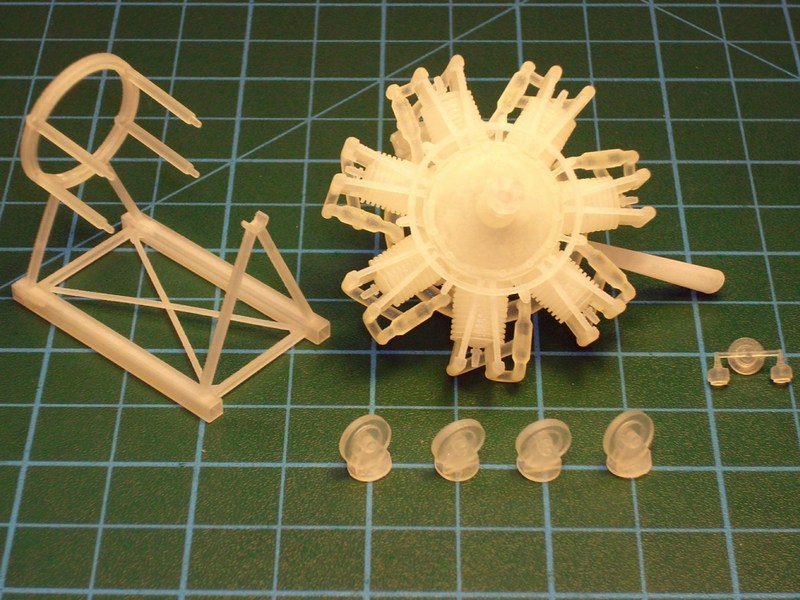 As soon as both engine miniatures unpacked from plastic bags shipped from Shapeways and carefully examined, they were dipped into White Spirit for a couple of minutes to clean the oil & wax traces left from MJM process while 3D printing. Shortly after parts were washed and allowed to dry, a layer of Ammo Mig Jimenez AMIG2004 White waterborne polymer primer airbrushed over to spot cracks & imperfections and prepare for paintjob. Since I do not consider myself a highclass modeller and I had no experience to paint realistic way radial engines, I thought as a good idea to follow proven techniques described by Mr. Javier López de Anca García into the Airplanes in scale - The greatest guide book, hoping that I could achieve some decent results. 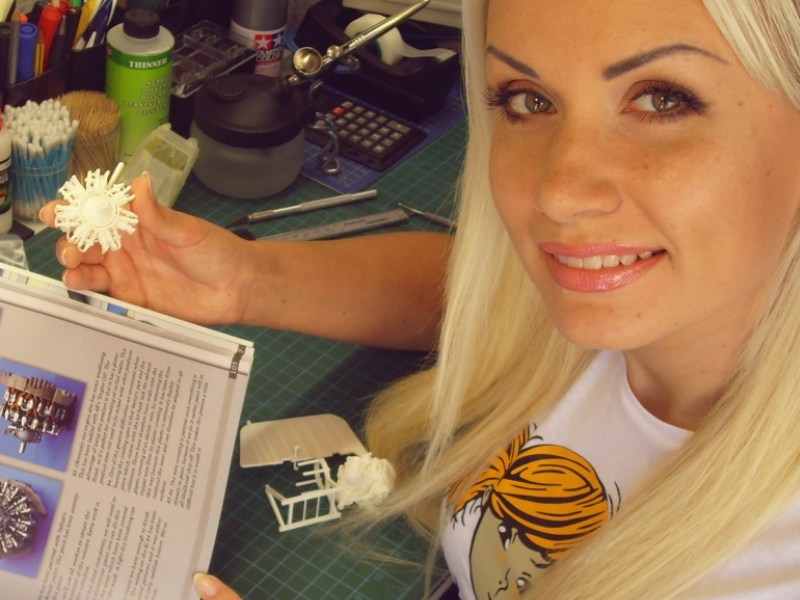 Both engines received an overall base coat of Alclad II metal laquers. When metal paint completely dried, a dark oil paint wash followed using the 502 Abteilung Black by MIG Productions. Later, the aluminum paint got some slightly different burnt tone, by airbrushing thinned MIG-098 Light Blue acrylic crystal around the base of each cylinder and some MIG-093 Red acrylic crystal around the head of each cylinder. The engines crown got some Life Color UA504 RLM 02 Grau acrylic paint and rivets shadowed with Dark Grey oil paint. As for the collector exhaust ring & pipes, they initially were painted with FS3004 Matt Burnt Umber available by Life Color as LC37 acrylic and later repeatedly washed with dense oil paint mixture of Vandyke Brown available by Winsor & Newton, thinned with White Spirit to a consistency between a filter and a wash. Some Light Rust available by AK Interactive as AK046 filter also randomly brushed on exhaust pipes. 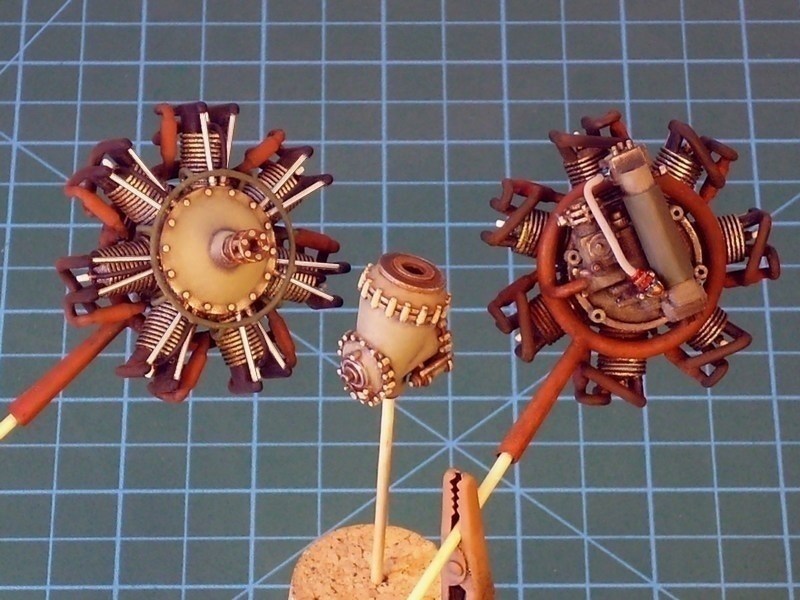 Düzenleyen Nick_Karatzides - 27/07/2018 Saat 12:28 |
|
 |
|
| << Önceki Sayfa 4 Sonraki >> |
  |
||
Forum Atla |
Kapalı Foruma Yeni Konu Gönderme Kapalı Forumdaki Konulara Cevap Yazma Kapalı Forumda Cevapları Silme Kapalı Forumdaki Cevapları Düzenleme Kapalı Forumda Anket Açma Kapalı Forumda Anketlerde Oy Kullanma |
|